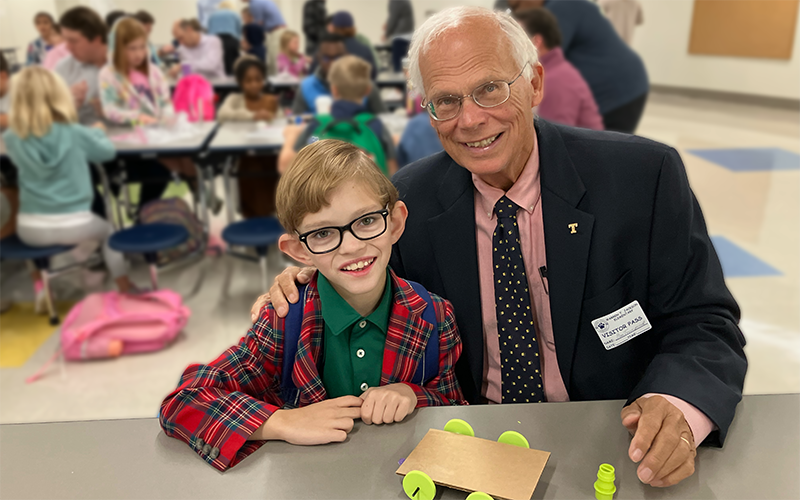10x10x Tech
| Categories: Alumni Interest

Legends
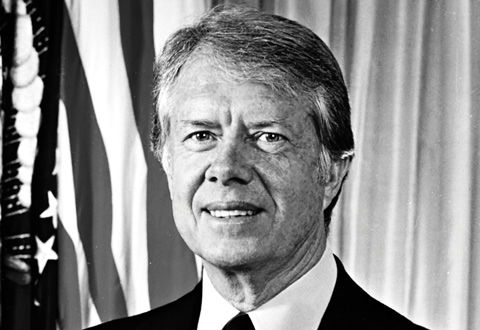 1. Jimmy Carter
1. Jimmy Carter
CLS '46, 39th U.S. President, Humanitarian
From his humble roots in rural Georgia, Jimmy Carter ascended the political ladder straight to the top. He studied at Georgia Tech and the U.S. Naval Academy and served a term in the Georgia governor’s mansion along his way to the White House in 1977. Upon leaving the Oval Office in 1981, Carter set a new course, one oriented around philanthropy and humanitarian efforts. He and his wife, Rosalynn, founded the Carter Center, dedicated to “Waging Peace. Fighting Disease. Building Hope.” The center’s ongoing multifaceted programs reach the far corners of the globe and range from Guinea worm eradication to mental health treatment to conflict resolution. Carter was awarded the Nobel Peace Prize in 2002 for his “decades of untiring efforts to find peaceful solutions to international conflicts, to advance democracy and human rights, and to promote economic and social development.”
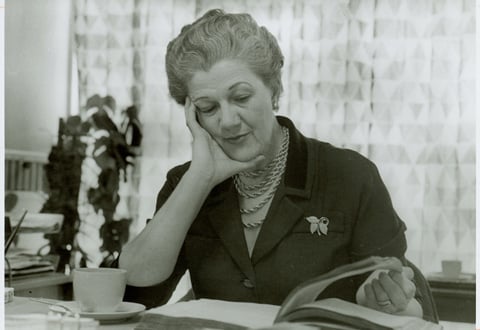 2. Dorothy Murray Crosland
2. Dorothy Murray Crosland
Hon '61, Director of Libraries
In 1925, Dorothy Murray Crosland came to work at Georgia Tech as an assistant librarian. Through her tireless work at Tech and in the library community, she earned a national reputation. Crosland assumed responsibility for building the library's collection, and determined that it should rival those of MIT and other leading technological institutes. She served on a number of boards, including as president of the Southeastern Library Association and the Georgia Library Association. She oversaw the construction of the S. Price Gilbert Library and Graduate Addition—the latter of which would be renamed the Crosland Tower in her honor. Crosland’s influence and responsibilities went far beyond the library. Upon discovering that Georgia was the only state that didn't have an engineering or architecture school for women, she wrote a persuasive letter to the Georgia Board of Regents.
No surprise that Tech admitted its first women students soon after in 1952. Crosland also played a key role in the founding of what would become the College of Computing. For all of her contributions, Tech made her an honorary alumna in 1961.
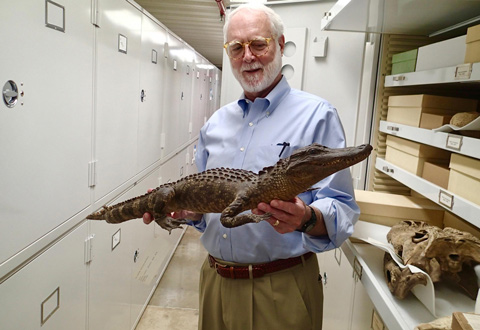 3. G. Wayne Clough
3. G. Wayne Clough
CE '64, MS CE '65, Hone PhD '15
Georgia Tech Emeritus President, Former Secretary of the Smithsonian Institution
G. Wayne Clough’s extraordinary tenure as the first alumnus president of Tech is summed up in a word: promise. Clough saw the promise, the potential that the university and its students held and spearheaded sweeping measures to fulfill that promise. During his 14-year tenure, Tech’s national rankings rose into the top 10 among public universities. The student population increased from 13,000 to 18,000. More than $1 billion was invested in new buildings and campus improvements. He established the G. Wayne Clough Georgia Tech Promise Scholarship, enabling hundreds of financially disadvantaged students to graduate debt-free. Clough subsequently applied his same visionary leadership as Secretary of the Smithsonian Institution. He presided over more than $1 billion in renovation and new construction, positioning the august institution to fulfill its promise and purpose—the increase and diffusion of knowledge—with renewed energy and robust resources in the 21st century.
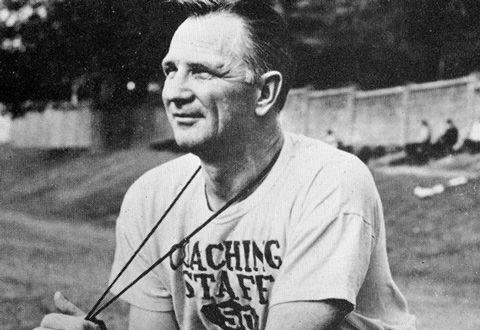 4. Bobby Dodd
4. Bobby Dodd
Former Head Football Coach
Namesake of Tech's Football Stadium
The Bobby Dodd Stadium at Historic Grant Field pays tribute to a legendary coach who dedicated more than four decades to Tech’s football program. During his 22-year career as head football coach, Bobby Dodd—a former star quarterback at Tennessee and a assistant coach at Tech for 15 years—led the Yellow Jackets to a national championship, victories in nine of the 13 major bowl games the team played and two Southeastern Conference (SEC) championships. He amassed 165 wins and nurtured 22 All-American players. After retiring as head coach in 1966, he remained as director of athletics for another decade, during which he received a “Citation of Honor” by the Football Writers Association of America for his contributions to the game. Further accolades followed after his death in 1988. The Tech stadium was named in his honor in 1989, and in 1993 he was inducted into the College Football of Fame a second time, as a coach.
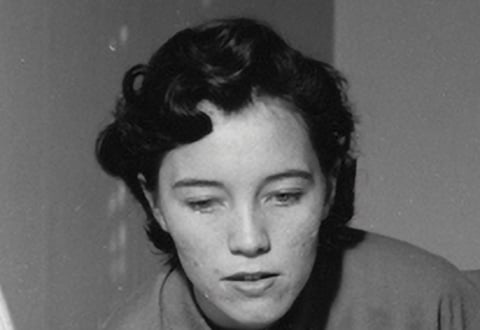 5. Shirley Clements Mewborn
5. Shirley Clements Mewborn
EE '56, One of the first two women to graduate from Georgia Tech
Shirley Clements Mewborn blazed a trail at Tech as both a student and an alumna. She was one of the first two female graduates, earning her degree in Electrical Engineering in 1956. Her 41 years of leadership in the engineering field earned her unanimous selection to the Georgia Tech Hall of Fame in 2003. She became the first woman to serve as president of the alumni association. She often gave speeches at Tech about perseverance and leadership—some of them as a guest coach for the women’s basketball team. Her dedication and generosity to her alma mater is evident on campus. Her name graces not only the softball stadium but the Shirley Mewborn Perseverance Scholarship, which supports the next generations of female Yellow Jackets in their studies at Tech.
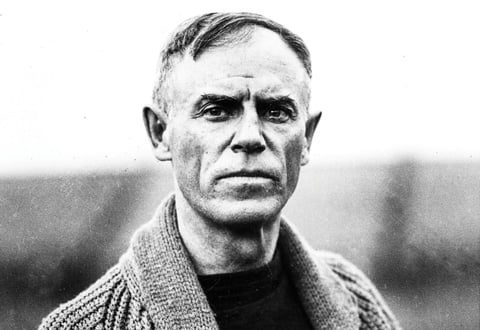 6. John Heisman
6. John Heisman
Fromer Head Football Coach
To the world, John Heisman is forever associated with college football, thanks to the trophy awarded in his name each season to the top college football player. But at Tech, he is a three-sport coaching legend. He served as Tech’s first basketball coach; the basketball venue bore his name in tribute for 18 years. He also coached the baseball team. Undoubtedly, though, Heisman’s greatest fame came on the gridiron. He coached the Tech football team through 16 winning seasons, a tenure that included a 32-game undefeated streak, three undefeated campaigns and four straight SIAA championships. His legacy extends far beyond his superlative record at Tech and 36-year coaching career. Among the game’s greatest innovators, he promoted the game’s split into quarters from halves and was responsible for legalizing the forward pass. He originated the center snap, quarterback count signals, double pass and the jump shift—better known as the Heisman shift.
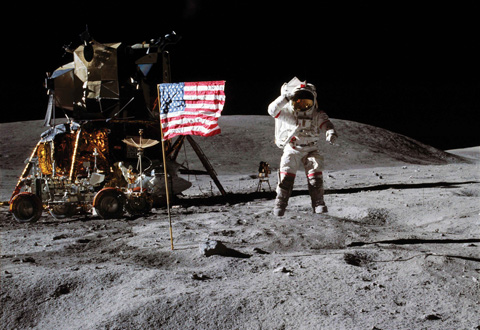 7. John Young
7. John Young
AE '52, NASA Astronaut
When John Young was selected in 1962 for the “New Nine,” NASA’s second class of astronauts, it launched an unparalleled 42-year career that made him NASA’s most experienced astronaut. He was the first astronaut to travel into space six times and the only one to go into orbit as part of the Gemini, Apollo and Space Shuttle programs. As commander of Apollo 16 in 1972, he spent three nights on the lunar surface, joining an elite group of only 12 astronauts (and the only Georgia Tech graduate) who’ve ever walked on the moon. He was co-commander of the first flight of the Space Shuttle era. When on the ground, he nurtured the careers of many other astronauts through his position as Chief of the Astronaut Office, the most senior leadership position for active NASA astronauts.
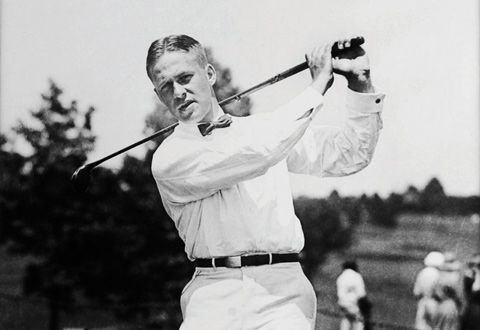 8. Bobby Jones
8. Bobby Jones
ME '22, Champion Golfer, Co-Founder of Masters Tournament
Robert Tyre “Bobby” Jones shocked the world when he retired as a golfer in 1930, right after winning the Grand Slam. But his influence on golf was just beginning, as he spent the following decades promoting and nurturing the growth of the sport. Hailed as the greatest amateur golfer of all time, Jones applied his expertise to design the next generation of golf clubs as well as numerous prestigious golf courses. He not only designed the course at Augusta National but co-founded the illustrious Masters Tournament that calls that course home. Among his many accolades and tributes—including membership in the Georgia Tech athletic and engineering halls of fame—is the U.S. Golf Association’s Bob Jones Award. The USGA’s highest honor, the annual award is bestowed on individuals who demonstrate the same spirit, personal character and respect for the game as Jones himself.
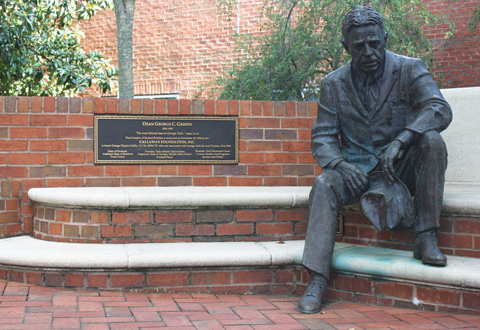 9. George C. Griffin
9. George C. Griffin
CE '22, MS IM '57, Dean of Students
Just how revered is George C. Griffin among Tech alumni and faculty? The former dean of students, considered “The original Mr. Georgia Tech,” is honored on campus every year on May 16th, Dean Griffin Day, for his lasting impact on his students and the university he so loved. Known as “a friend to every student,” Dean created an emergency loan program that he dubbed his “Hip Pocket Fund” that enabled countless students to remain at Tech when their money ran out. He established, with his own money, Tech’s Central Placement Office, a mission he continued after retirement by creating the Alumni Career Services Program. His seven decades of dedication to his alma mater are best reflected in the Dean Griffin Day Luncheon, which honors faculty, staff and teaching assistants who, through their own actions, emulate this Tech legend.
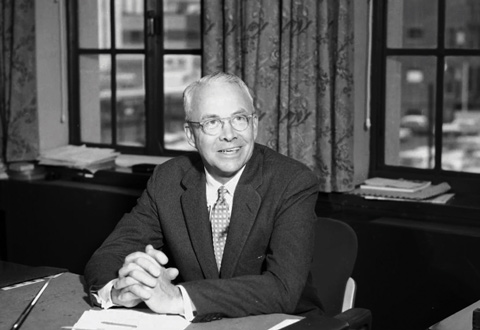 10. Ivan Allen Jr.
10. Ivan Allen Jr.
COM '33, Former Atlanta Mayor
Namesake of Tech's College of Liberal Arts
Ivan Allen Jr. was always Atlanta’s biggest booster. During his eight years as mayor from 1962 to 1970 and the decades before and after, the president and chairman of the Ivan Allen Company dedicated himself to growth, peace and progress for his hometown and its inhabitants. He turned Atlanta into a major league city, landing the Falcons, Hawks and Brewers. He cleared the way for MARTA, the completion of the downtown expressway system and the first direct international flights. His selection for the Martin Luther King. Jr. Nonviolent Peace Prize in 1981 honored his measures to end segregation in the city and success in keeping Atlanta peaceful when riots erupted elsewhere after King’s assassination in 1968. His passion for his alma mater—which he helped transform into a public policy powerhouse—is still reflected on campus today in the Ivan Allen Jr. College of Liberal Arts.
Researchers
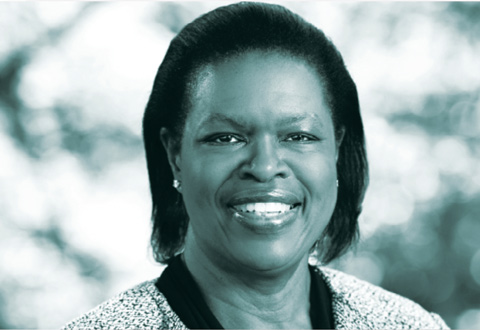 1. Kaye Husbands Fealing
1. Kaye Husbands Fealing
Chair and Professor of Public Policy
Kaye Husbands Fealing specializes in the science of innovation policy and the public value of federal research expenditures on research and development. But perhaps her most important and impactful work has been her dedication to addressing the underrepresentation of women and minorities in STEM fields and the workforce. In recognition of her efforts, she was named a 2017 Trailblazer Award winner for the National Medical Association Council on Concerns of Women Physicians. She developed a program at the National Science Foundation and serves on the NSF’s Committee on Equal Opportunities in Science and Engineering, where she is the liaison to the Directorate for Education and Human Resources Advisory Committee—providing advice, guidance, and recommendations on programs for education and human resource development. In addition, Husbands Fealing serves on the Executive Board of the American Association for the Advancement of Sciences (AAAS) and is an AAAS Fellow, and was recently elected a Fellow of the National Academy of Public Administration.
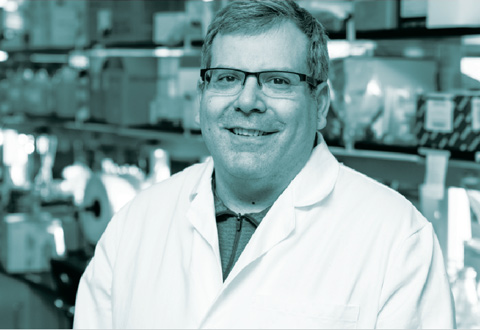 2. Philip Santangelo
2. Philip Santangelo
Professor of Biomedical Engineering
Phil Santangelo’s groundbreaking biomedical research is focused on three primary areas: native RNA regulation, RNA virus pathogenesis and RNA therapeutics and vaccines, where the application and development of imaging technology is applied to all three areas. The goal? His lab is developing RNA-based therapeutics and vaccines that could be used to fight the SIV and HIV viruses. His team is using PET/CT imaging tools for interrogating SIV infections to learn vital information that could be applied to approaches seeking to “cure” HIV. To address RNA regulation, localization and dynamics in the cellular milieu, his lab developed single molecule sensitive approaches for imaging native RNAs and RNA dynamics in live cells, as well as the first assay to detect native RNA-protein interactions in situ. To date, the results of these methods have been applied to the cell biology of human respiratory syncytial virus infections and RNA regulation during tumorigenesis.
 3. Nancey Green Leigh
3. Nancey Green Leigh
Associate Dean for Research, College of Design
For years, everyone from scientists to politicians to journalists have talked about the impact robots are having and will have on the economy and society in general. But it’s all been just that—talk. Georgia Tech’s Nancey Green Leigh, an expert on economic development planning, is cutting through the speculation and answering the question with hard evidence. She and her colleagues are gathering information for the first-ever dataset of robot use and development in the U.S. Through manufacturer and systems integrator surveys, workforce analysis and case studies, Leigh looks deeply into such topics as robots and the future of employment, the changing nature of the workplace, the strategies of independent robotics firms, and the rapid evolution of robotics technology. The goal is for Leigh’s findings to enlighten and enable policymakers, workers and corporate leaders to make informed decisions as these machines become commonplace in nearly all lines of work.
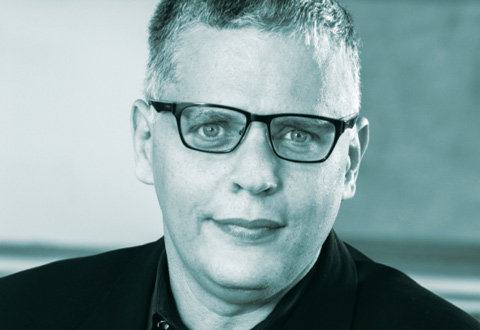 4. Gil Weinberg
4. Gil Weinberg
Director of the Center for Music Technology
In addition to his teaching position in School of Music, Gil Weinberg is also the founding director of Georgia Tech’s Center for Music Technology. His research focuses on creating innovative music tech that can revolutionize the way in which we create, experience, and learn music. Within the Center, Weinberg heads up the Robotic Musicianship Group, which develops artificial creativity and musical expression for robots and augmented humans. Thus far, the project has manifested itself in a robot that plays the marimba using machine learning for jazz improvisation and a prosthetic arm that restores, and in some cases even enhances, an amputee’s ability to play the drums. Weinberg’s robotic music has been performed all over the world with orchestras like Deutsches Symphonie-Orchester Berlin, the National Irish Symphony Orchestra, and the Scottish BBC Symphony.
He also organizes the annual Guthman Musical Instrument Competition at Tech, which attracts inventor/musicians from all over the world to compete and showcase their novel instruments and give listeners an idea of what music might sound like in the future.
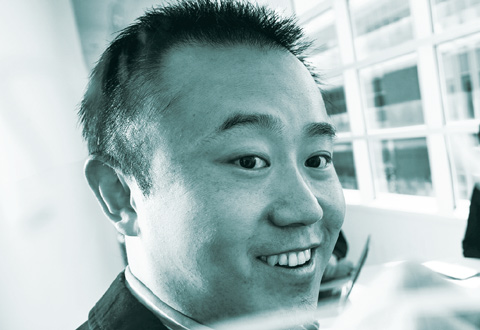 5. Jimeng Sun
5. Jimeng Sun
Associate Professor of Computational Sceince and Engineering
A decade ago, artificial intelligence (AI) was little more than a theory. But today, scientists like Tech’s Jimeng Sun are finding real-world applications for AI. Sun is one of the first researchers to introduce the technology to healthcare. Sun has currently turned his attention to computational phenotyping, with the goal of converting terabytes of electronic health records into applicable information for doctors and healthcare providers. He has used this methodology, called tensor factorization, to make breakthroughs that include development of a model to automate sleep-study scoring, creation of algorithms that can detect heart failure six months in advance, and the use of deep learning methods to diagnose pediatric patients at Children’s Healthcare of Atlanta. Sun’s worked has earned him a number of accolades, the most recent of which is being named one of the Top 100 Leaders in Drug Discovery and Advanced Healthcare, a global distinction for thinkers driving the field of data-fueled healthcare.
 6. Brian Stone
6. Brian Stone
Director of the Urban Climate Lab
Brian Stone’s current work is an especially hot topic. A professor in Georgia Tech’s School of City and Regional Planning, Stone teaches about climate change and urban environmental planning. His research focuses on spatial drivers of urban environmental phenomena, specifically urban heat islands created by human activity and concentration and the building materials that trap warmth, causing temperatures to increase and air quality to decrease. Stone leads the Urban Climate Lab, a cadre of Tech researchers who are looking into the connections between climate change and the artificial environment and using expertise in environmental science, urban design, and public health to formulate strategies to combat climate change in cities. His work on urbanization as it relates to warming has been featured on CNN and NPR, and in Forbes, The New Yorker, Wired and The Washington Post. His book, The City and the Coming Climate: Climate Change in the Places We Live (Cambridge University Press) recently won the Choice Outstanding Academic Title Award.
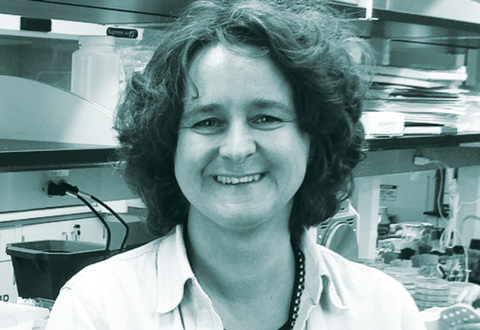 7. Francesca Storici
7. Francesca Storici
Professor of Biological Sciences
In 2016, Storici was named one of 84 people from the U.S.—and the first and, thus far, only Georgia Tech researcher—to receive the first-time $1.5 million Howard Hughes Medical Institute (HHMI) Faculty Scholarship, geared toward “early career scientists who have great potential to make unique contributions to their field.” It was just another first for Storici, who is widely known in the scientific community as a trailblazer in the new field of RNA-mediated genome stability. Her lab research focuses on things like RNA-driven DNA repair and modification, the function of ribonucleotides embedded in DNA, the mechanisms of genome stability, and the targeting, correction and editing of genes. Storici’s work led to the discovery of a new method of DNA repair using the transcript RNA, which are abundant in cells, as a template. The result might have a significant impact on genetic stability.
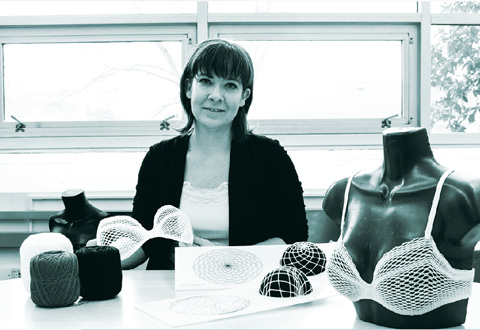 8. Lisa Marks
8. Lisa Marks
Assistant Professor, School of Industrial Design
In a world constantly preoccupied with innovation and technology—sleeker, faster, more automated—Lisa Marks wanted to take a different approach on design and problem solving. Her research into traditional hand crafts and their applications in the real world led her to an approach that embraces culture and innovates the forgotten. Marks hasn’t turned her back on technology, rather she used algorithmic modeling to accentuate endangered traditional handcrafting. In so doing, she developed a revolutionary garment that can help ease women’s suffering all over the globe. Her Algorithmic Lace project combines novel, computer-driven algorithms with old-fashioned, hand-bobbin lace weaving to create a 3D lace that can be fashioned into a custom-fit, post-mastectomy bra. The design not only alleviates the discomfort that is common for women after surgery, but her methods also rejuvenated a fast-fading art form. Marks was named winner of the Grand Prix at the Lexus Design Award Event, a competition that received more than 1,500 entries from creators worldwide.
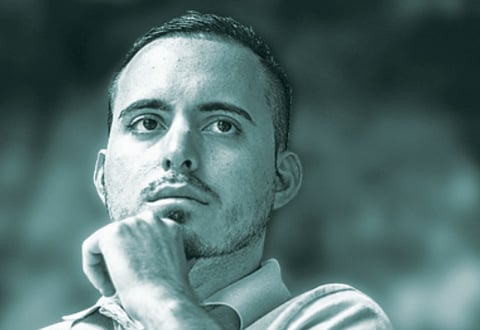 9. Ignacio Montoya
9. Ignacio Montoya
MS ME '18
Executive Director of Hinri Labs
Even when the odds weren’t in his favor, Ignacio Montoya always managed to find his way. After his mother died when he was 5, Montoya and his father left Cuba for the U.S. so he could pursue a dream of being a pilot and study at Georgia Tech. But in 2012, he was in a car crash that put him in a coma for three months and then left him paralyzed. “My body was paralyzed, but my mind wasn’t paralyzed,” Montoya says. Six years later, he graduated with his master’s in biomedical innovation and development and a position as as the neurorecovery executive director HINRI Labs in Atlanta, which is focused on changing the standard of care for spinal cord injury patients. “We’re going after the long-term solutions,” he says. “We don’t want to improve the daily lives of these people; we want to get them out of a wheelchair.” He sees his own body as a research laboratory. “The protocols that I create, I implement them on myself first,” he says. In the next 10 years, Montoya wants to get hundreds, if not thousands, of people out of wheelchairs. Engineer, heal thyself indeed.
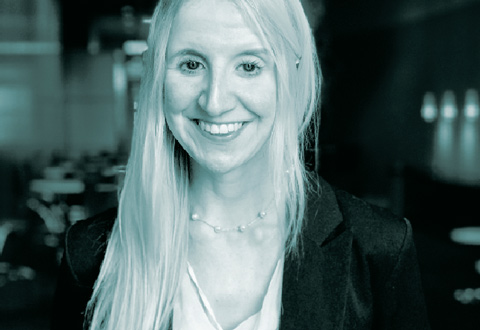 10. Caitlyn Seim
10. Caitlyn Seim
EE '13, PhD HCC '19
Postdoc Research at Stanford UniversityRecent doctoral graduate Caitlyn Seim’s research focuses on human cognition and learning from haptic interaction—responding to touch and motion technologies—to create new lightweight, mobile devices for rehabilitation. This spring, Seim was awarded an exclusive Neuroscience:Translate grant from Stanford University to augment her research into passive haptic stimulation. During her time at Georgia Tech, and with guidance from Professor Thad Starner, she designed a special glove that could be used to assist in stroke rehabilitation. Stroke survivors often lose function in their arms or hands, making it difficult to perform everyday functions like dressing or eating. Seim aims to further investigate how haptic gloves may provide therapy on-the-go for patients who don’t always have access to high-intensity rehabilitation.
Traditions
 1. Ramblin Wreck
1. Ramblin Wreck
The original Ramblin’ Wreck car—a 1914 Model T driven by Dean Floyd Field in the 1920s—might have been aptly named, but today’s version is anything but. The painstakingly restored and maintained 1930 Model A Ford arrived on campus in 1961, and has led the football teams onto the gridiron ever since. While the Ramblin’ Wreck is used primarily for on-campus activities, it’s also made appearances for games in Denver, El Paso, Tex., and Jacksonville, Fla. To help fund its ongoing maintenance, it is also rented out for weddings and birthday parties.It’s occasionally been the target of pranksters. In 1963, University of Tennessee vandals splashed orange paint all over the car, and a small amount of orange paint still flecks the struts. The Wreck sustained more significant damage in the summer of 2007 when a trailer failed while it was being towed to a wedding. The good news?
The iconic vehicle was repaired in time to lead the football team out onto the field that fall. These days, Georgia Tech takes every precaution to ensure that the Wreck is safe and ready for the next century. “They’ve got it down to a science,” Living History Director Marilyn Somers says of the student-led Ramblin’ Reck Club. “They know how to handle it, and it’s always got somebody securing it.”
 2. Homecoming
2. Homecoming
- Freshman cake race. The freshman cake race earned its name in 1913 thanks to the tasty prize delivered to the winner. By 1935, the race was mandatory. These days, it’s optional, but any first-year student willing to wake before dawn to participate in the co-ed, half-mile sprint earns a cupcake. The top male and female finishers earn a full cake—and a kiss from either the Homecoming King or Homecoming Queen.
- The Mini 500. Grab your pit crew, hone your riding technique, and hop on a mode of transit you probably haven’t seriously considered since your pre-school days. The Mini 500 tricycle race attracts 51 teams of seven vying to finish the 10 or 15 laps around Peters Parking Deck first. Engineers’ skills are put to the test: What’s the best way to reinforce a trike designed for toddlers?
How can the pit crew shave precious seconds off of required wheel changes? And most important: What’s the best way to highlight a strong performance on a job resume?
- Ramblin Wreck Parade. Since 1932, the Ramblin Wreck Parade has been an ideal venue for students to showcase their engineering ingenuity. The parade features classic, themed, and contraption cars that get judged on both creativity and effectiveness. Past entrants have included some remarkable vehicles, from a spinning water cyclone to a Scooby-Doo themed Mystery Machine.
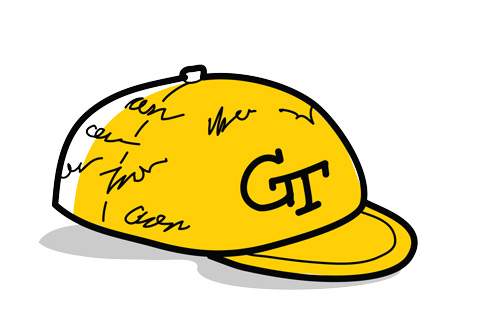 3. Rat Caps
3. Rat Caps
In 1914, James Herty Lucas wrote an editorial in The Yellow Jacket Magazine proposing that all new students wear a RAT Cap, a common practice on many campuses at the time. The editorial proved persuasive: RAT caps made their debut at Georgia Tech in the fall of 1915, emblazoned with a white “F” for freshman. (It was later swapped out for the more familiar “GT.”) Eventually, the short-brimmed caps became more personalized: Students had to write their last names on the front bill, their graduation year, and the phrase “To HELL with georgia” on the back. Students also received detailed instructions on other written requirements: hometown and state, and scores of football games. Those who didn’t wear the cap risked a variety of punishments: among them, being listed on the Freshman Slacker List in the Technique, or appearing—and often being punished—through “RAT courts.”
Today, all incoming first-year students receive a RAT cap as a keepsake at Convocation, though typically only members of the band wear them regularly to practice and band camp. “They are the stalwart keepers of traditions,” says Living History's Marilyn Somers.
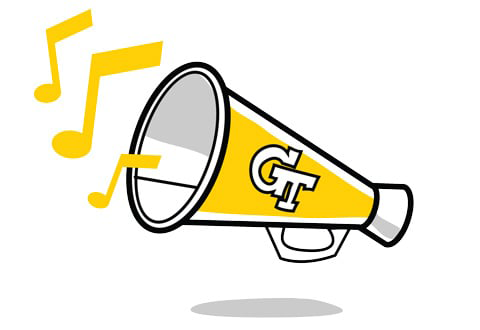 4. Ramblin Wreck Fight Song
4. Ramblin Wreck Fight Song
“(I’m a) Ramblin’ Wreck from Georgia Tech” is among a handful of the most well known fight songs in the country, and its lyrics are uniquely its own. But it’s had to wrest the title from other schools who have used versions of the song for their own teams. The original composition upon which “Ramblin’ Wreck” is based, “Son of a Gambolier,” was a drinking song composed in the late 1800s. (A gambolier, by the way, is someone who likes to have a good time, often irresponsibly.) The tune was adapted as a fight song by Dickinson College, South Dakota School of Mines and Technology, Colorado School of Mines, Ohio State University and Rensselaer Polytechnic. Not all continue to use the melody today—and none have gone on to reach the legendary status of Tech’s song. While fight songs aren’t typically known for their modesty or civility, various lyrics have caused agitation for more than a century: In the 1908 Blueprint, the words “hell” and “helluva” were expunged for being “too hot to print.”
For now, the lyrics have remained—and the world still loves the tune. In 2017, USA Today named it one of the 10 best fight songs in college football. UGA’s (obviously) didn’t make the cut.
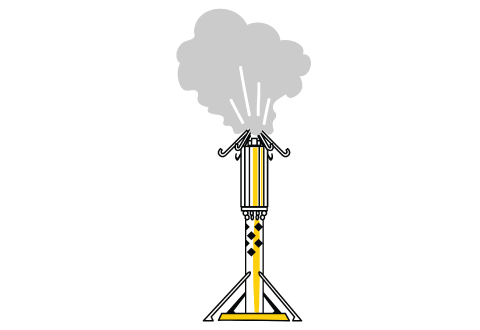 5. The Whistle
5. The Whistle
You never have to set foot on Georgia Tech’s campus to hear the steam whistle, one of the school’s most iconic sounds: You just have to be on a phone call with someone on campus at the right time. Steven Girardot, associate vice provost for undergraduate education, told a reporter in 2018 that he’s received plenty of bewildered queries over the years. “The most common question I get from people outside of Georgia Tech who aren’t familiar with the whistle is, ‘Are you in a train station?’” The whistle has been blowing since 1888. It’s most frequently used to mark class-changing times, and for touchdowns and football victories when the Yellow Jackets are playing at home. It’s also used during a ceremony to honor the memory of those who have passed away in the previous year. While the whistle might be a quintessential part of the Georgia Tech experience, it’s not universally beloved. In 1981, after a flurry of complaints from residents, Georgia Tech silenced the whistle. Later, an even larger outcry from steam whistle supporters led Tech to reverse the decision. These days, a computerized atomic clock keeps everything on track, and the steam whistle’s continued presence on campus seems assured. But it has seen one recent change: Because the campus has grown significantly since the 1800s, the class-changing times were increased to 15 minutes in 2017—requiring the steam whistle’s schedule to follow suit.
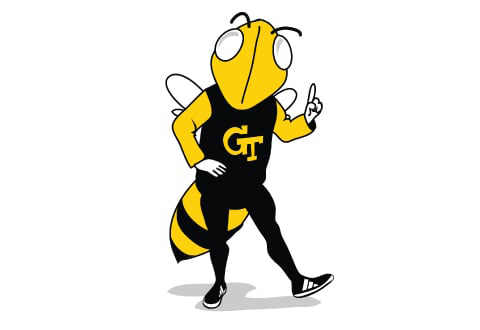 6. Buzz
6. Buzz
Over the years, plenty of students have donned a bee costume to cheer on Georgia Tech. But it was the efforts of Richie Bland, Phys 81, that really helped the mascot Buzz —pardon the pun—take flight. With the help of a Six Flags–approved seamstress, Bland donned a foam-headed, Converse-wearing Buzz costume. He captured the imagination of fans when he sprinted out onto the football field during halftime of the Georgia Tech–Florida Gators game in the fall of 1980. Security was less enthusiastic: They escorted him off the field. After a bit of time and strategizing, Georgia Tech officials welcomed Buzz back to the field. In the years since, plenty of talented performers—both men and women—have donned the costume, and earned a scholarship for their efforts. They’ve also won armfuls of awards and honors: In 2000 and 2001, Buzz earned the National Cheerleaders Association mascot of the year, and in 2005 and 2006, Buzz was named to the Capital One All-American Mascot Teams. Buzz is as recognizable as ever, but has undergone one recent change. When Adidas became the official apparel provider for Tech in 2018, Buzz swapped out Chuck Taylors for some custom-designed Adidas kicks.
 7. George P. Burdell
7. George P. Burdell
When Ed Smith, CerE 27, made the impish decision to enroll the fictional student George P. Burdell at Georgia Tech in 1927, he might’ve assumed he was playing a short-lived prank. Instead, he created a legend. Smith kept up the ruse by enrolling Burdell in the same classes he had. He carefully completed all of the homework twice—with modest changes to ensure none of the professors caught on. “Burdell” went on to earn a bachelor’s degree and master’s degree—and remains on the active student rolls. Every generation of students has breathed new life into the legendary character: Burdell served in World War II, spent more than a decade on Mad magazine’s board of directors, and was a potential candidate for Time’s person of the year in 2001 (briefly giving eventual winner Rudy Giuliani a run for his money). Burdell’s name was engraved on the Georgia Tech–built Prox-1 satellite, which was launched into space this past June. Burdell has even been updated for the Digital Age: You’ll find at least a dozen Twitter and Instagram accounts linked to Burdell, not to mention a LinkedIn account or two. Students love him as much as ever. On the RateMyProfessors website, more than 100 students have taken the time to praise Burdell as a professor of—well, almost everything. “One word,” wrote a recent gushing commenter about Burdell: “Unreal.”
 8. Drownproofing
8. Drownproofing
Freddy Lanoue, a revered swim coach at Georgia Tech and an accomplished swimmer and diver in his own right, didn’t believe in doing anything halfway. As the world edged ever closer to war in the late 1930s, officials in the Navy tapped him for a big job: come up with a water survival technique that sailors could use to stay alive in worst-case scenarios. He did. His “drownproofing” method — a process that allowed people to stay alive in the water for hours while conserving energy—was adopted by the Navy and continues to be taught to Navy SEALS today. Among Lanoue’s first guinea pigs as he honed his method were Georgia Tech athletes and students, who ultimately learned to perform the technique with both their arms and legs tied. The skill was considered so essential that it was a graduation requirement—at least some version of it—for students until 1986. Most alumni consider learning it a badge of honor. While students today might not be familiar with drownproofing, there’s no question it's had a lasting impact, says Tech’s Living History Program Director Marilyn Somers. “I go out and tell stories and mention drownproofing. People almost always come up to tell me their story about how they used it to save their life,” she says. “It really does work.”
 9. Animal Affinity
9. Animal Affinity
- In 1929, Georgia Tech’s football team received a live bear cub after besting California in the Rose Bowl. Football player Stumpy Thomason took over the care and feeding of the animal. While “Stumpy’s bear” occasionally got in trouble for pawing through garbage cans during his frequent appearances on campus—Dean Griffin described him as “smart as most Tech students with all the bad habits of modern youth,” the bear’s tenure on campus was fairly short-lived. Thomason took the bear with him when he moved to New York to take a coaching position with (appropriately enough) the Buffalo Bears.
- In 1945, a white terrier with black patches named Sideways ambled onto Tech’s campus and straight into the hearts of the Tech community. She earned the moniker because of a surgery that caused her unconventional gait and quickly became a star on campus, attending classes and even leading the football team onto the field. Though she died just two years after her arrival, she is buried on campus under a monument near Tech Tower.
- Another animal superstar was Clifford the Lion, who arrived on campus in 1961 with football player Joe Auer. For a lion, Clifford was well behaved: potty-trained and docile. He lived in Cloudman Hall, where residents would occasionally walk to the lavatories late at night, half-asleep, only to be startled fully awake by Clifford’s hot breath on the back of their legs. As Clifford got older, he began growling at night — a problem that eventually led students in the hall to sign a petition to send him away.
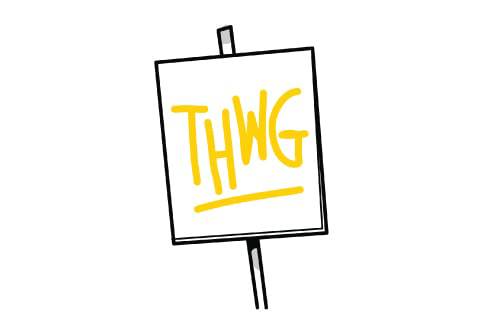 10. The Good Word (THWg)
10. The Good Word (THWg)
It’s hell on copy editors and spellcheck programs, but to Tech students and alumni, the best (and only) answer to “What’s The Good Word?” is “To Hell With Georgia!” The sentiment is clear enough on its own, but true Tech fans know that they can add insult to injury by using a lowercase letter when referring to their most-loathed rival, the University of Georgia. Often shortened to its common initialism, THWg, the slight is even sharper when the lowly preposition “with” gets capitalized. But Georgia? Forget it. (There’s a reason the annual clash is known is “Clean, Old-Fashioned Hate.”) The adversarial relationship got its start in 1893, when the two institutions’ football teams met for the first time on UGA’s home turf. Despite a raucous crowd, Tech stomped its way to a 28-6 victory. Since then, Georgia has built an edge in the ongoing series, but Tech has its own claim to fame: the longest streak of victories. Between 1949 and 1956, Georgia Tech didn’t lose a single contest. If the phrase was initially meant to demean Tech’s primary rival, it has since become a community builder. Successfully completing the eight-word call and response is the quickest way for alumni of all ages to signal that they share a common enemy—and a common bond.
Campus Leaders
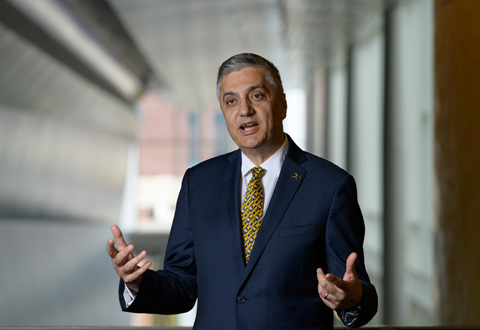 1. Chaouki Abdallah
1. Chaouki Abdallah
MS EE '82, PhD EE '88, Executive Vice President Of Research
For Chaouki Abdallah, the Institute’s vision statement serves as a daily directive: Georgia Tech will define the technological research university of the 21st century. While his own research and courses in the School of Electrical and Computer Engineering focus on control and communications systems, Abdallah’s role on the Executive Leadership Team charges him with oversight of Tech’s complete research program, which reached $1 billion in new grants, contracts and other awards in fiscal year 2019. This IEEE Millennium Medal recipient is now front and center on Tech’s most ambitious projects, from its highly successful commericialization efforts to the Georgia Tech Research Institute (GTRI)—which serves an increasingly vital role for national security—to the research being conducted at the cutting-edge, $355 million new Coda building on Tech Square.
 2. Karen Fite
2. Karen Fite
HS '78, Interim Vice President and Director of the Enterprise Innovation Institute
Innovation doesn’t exist in a vacuum. Throughout her 26 years of economic development experience at Georgia Tech, Karen Fite has served as an indispensable conduit between the university and Georgia’s businesses, fostering partnerships and channeling resources that propel all parties forward in their innovative initiatives. Now in her role as Interim Vice President and Director of the Enterprise Innovation Institute (EI2), Fite provides leadership across all 12 of the institute’s programs, advancing commercialization, entrepreneurship and business and industry services throughout the state. Since 2013, Fite has served as director of the largest of EI2’s programs, the Georgia Manufacturing Extension Partnership (GaMEP). The partnership elevates the competitive position and economic impact of Georgia companies by connecting them with Tech’s vast resources on safety, procurement, trade and other vital aspects of business development. Fite’s decades of dedication have helped EI2 grow into the largest and most comprehensive university-based program of its kind in the nation.
 3. Zvi Galil
3. Zvi Galil
Professor and Former Dean of Computing
Georgia Tech’s College of Computing may not bear Zvi Galil’s name, but it has his signature all over it. During Galil’s transformational nine-year tenure as the John P. Imlay Jr. Dean of Computing—from which he stepped down this year—the college rose into the top 10 nationally and internationally. Applications increased 10-fold and undergraduate enrollment doubled, making computing the largest and most selective major at the university. Galil oversaw the launch of Tech’s highly successful and groundbreaking Online Master of Science in Computer Science program, which has since been joined by similar programs in analytics and cybersecurity. The annual Computing Career Fair sets attendance records annually, with more than 160 companies competing to hire Tech students. During his last year as dean, participation in the college’s corporate affiliate programs (CAP) quadrupled, with 63 companies raising $1.13 million in fiscal 2019. That successful fundraising has helped establish four Interdisciplinary Research Institutes and four Interdisciplinary Research Centers, double the number of endowed senior faculty chairs to 10 and increase faculty from 85 to 102, with even more members slated to join this academic year.
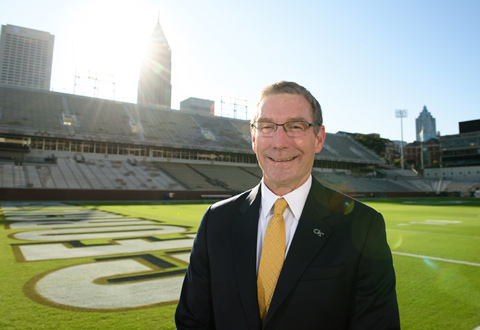 4. Todd Stansbury
4. Todd Stansbury
Director of Athletics
In less than three years since he returned to his alma mater Georgia Tech as Athletic Director in 2016, Todd Stansbury has changed the face of Tech athletics—literally. Last year, the former Yellow Jacket linebacker not only oversaw a record-smashing fundraising year with more than $50 million in donations, but he also initiated a makeover in form of facilities upgrades, a landmark apparel and equipment sponsorship with Adidas, and an overall brand enhancement that codified the official Tech colors and logo. He’s an impact on the field as well: In 2018-19 alone, the school jumped 55 spots in the Learfield IMG Directors’ Cup Standings from 121st to 66th in success in all sports. But perhaps most importantly, under Stansbury’s tenure, the school became the only member of a Power Five conference to put up a multiyear Academic Progress Rate higher than the national average in every sport. And his student athletes have achieved an NCAA Graduation Success Rate of 89 percent—the highest in school history.
 5. Renee Kopkowski
5. Renee Kopkowski
Vice President of Institute Communications
It’s Renee Kopkowski’s job to articulate for the world the answers to the question, “What does Georgia Tech think? Since joining Tech earlier this year, she’s focused the Institute Communications team on being the voice of Tech, increased transparency and advancing the Institute’s strong reputation. Her distinguished career in strategic communications serves as a springboard for these activities that aim to fortify the long-standing links between Tech and its countless partners in business and industry. Kopkowski’s decade in high-level communications roles for Mars, Incorporated, a $33 billion global food company, honed her ability to promote innovation and global thought leadership through communications. As president and partner at strat-igence, she leveraged all media channels to elevate the profile of clients in numerous industries. Her skills in advancing clients’ interests across state, national and international levels will guide Tech in its vision of defining the premier technological research university of the 21st century.
 6. Bonnie Ferri
6. Bonnie Ferri
PhD EE '99, Vice Provost of Graduate Education and Faculty Development
After 31 years on the faculty of Georgia Tech, Bonnie Ferri is a wealth of institutional knowledge about how the university has evolved to keep pace in an era of dizzying technological change. Now the Vice Provost of Graduate Education and Faculty Development, Ferri was Tech’s first female PhD graduate in electrical engineering and the first female faculty member in Electrical and Computer Engineering (ECE). She is a celebrated innovator who pioneered mobile hands-on learning and inexpensive portable experiments in ECE courses—advances earned her both the prestigious IEEE Undergraduate Teaching Award and Regent’s Award for the Scholarship of Teaching and Learning. Her keen foresight made her the ideal candidate to serve as co-chair of the Commission on Creating the Next in Education. Along with more than 50 faculty, staff and students, she helped guide the Institute-wide effort to envision the Georgia Tech of 2040.
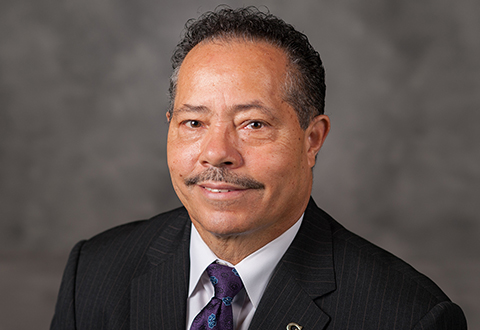 7. Archie Ervin
7. Archie Ervin
Vice President and Chief Diversity Officer
Not only is he Georgia Tech’s top expert on diversity, Archie Ervin is also a nationally recognized thought leader on diversity, equity and inclusion in higher education. He is currently serving his second two-year term as president of the National Association of Diversity Officers in Higher Education, the largest professional association of higher education chief diversity officers with a membership of more than 900 professionals representing more than 300 colleges and universities. He also is a founding member of of the association—which is the preeminent voice for inclusive excellence in U.S. higher education—and has served continuously as either a board member and/or officer since its inception. At Tech, Ervin has been a member of the president’s cabinet since he was hired in 2010, and is responsible for identifying institutional priorities, policies, programs and initiatives that advance the Institute’s inclusive excellence agendas for faculty, staff and students. Additionally, he serves as the liaison for ensuring compliance with nondiscrimination and equal opportunity laws and regulations, and chairs the implementation committees for two institutional initiatives: Black Student Experience Task Force and Gender Equity Initiatives. Under his leadership, Georgia Tech is a six-time recipient of the Higher Education Excellence in Diversity Award from INSIGHT into Diversity.
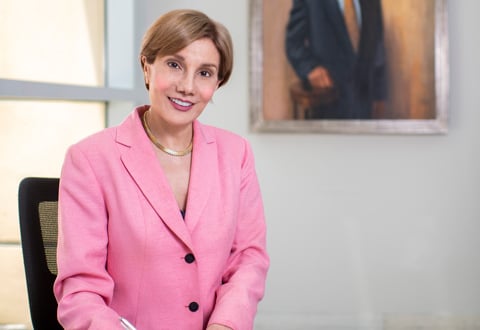 8. Maryam Alavi
8. Maryam Alavi
Dean of the Scheller College of Business
True to her standing as a thought leader on digital business transformation, Maryam Alavi has been a driving force for change and growth during her tenure as dean of the Scheller College of Business. Over the past five years, the college has risen in both national and global reputation, grown in size and diversity in their three flagship MBA programs, advocated for gender equality and women in business and successfully expanded its outreach to alumni and the community. Alavi has launched several new programs including a dual MD/MBA program with the Morehouse School of Medicine, and dual MBA/MS and MBA/PhD degrees in collaboration with other Georgia Tech colleges. For her leadership in technology and education, Alavi was named the 2017 Woman of the Year by Women in Technology (WIT) in Georgia. The award recognized Alavi’s accomplishments as a mentor and role model for women and men pursuing careers in STEM fields.
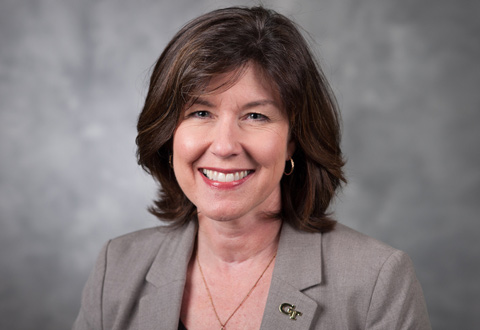 9. Lynn Durham
9. Lynn Durham
Vice President of Institute Relations
As a long-time advisor to student organizations, Lynn Durham demonstrates Tech’s commitment to the successful transition and engagement of new and returning students resonates from top to bottom. It’s a natural extension of her custodianship for all students on campus that she has shown since joining Tech in 1995 and especially as a member of Tech’s Executive Leadership Team. After becoming associate vice president and chief of staff in 2010 for then Tech President G.P. “Bud” Peterson, she spearheaded campus initiatives in such critical areas as student mental health and sexual violence prevention. She not only tackled ethics awareness, but also led the search for a vice president for ethics and compliance. In her new role leading Institute Relations, she serves as an ambassador both on campus and beyond, taking input from students, faculty and alumni, as well as civic and corporate leaders, and helping turn it into action for the advancement of the Institute.
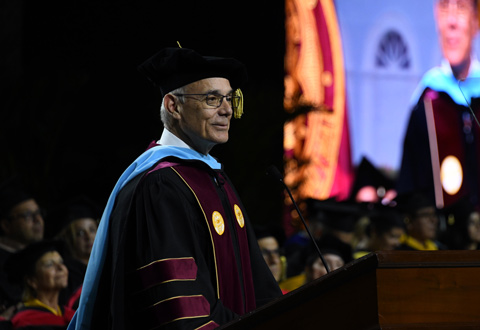 10. Rafael L. Bras
10. Rafael L. Bras
Provost and Executive Vice President for Academic Affairs
Rafael L. Bras’s tenure at Georgia Tech is marked by some of the Institute’s boldest innovations. In his leadership position, he has sought to provide a unique undergraduate learning experience, expand access to the world’s learners, and inspire the campus community through the arts. His vision for a 21st-century Georgia Tech guided Library Next, a multimillion-dollar, technology-focused reimagining of the intellectual center of the campus. Bras, the K. Harrison Brown Family Chair, launched the visionary Commission on Creating the Next in Education, an Institute-wide effort dedicated to new pilot programs that offer on-demand, real-time solutions for future learners. He led the opening of the Institute’s global campus in Shenzhen, China. His tenure has also seen the launch of the pioneering Online Master of Science in Computer Science (OMSCS) program, as well as online degree programs in analytics and cybersecurity, that together enroll more than 12,000 students globally. Bras’s passion has also ignited the Arts@Tech initiative, bringing the arts to life through performances and events, as well as a public sculpture collection that includes tributes to civil rights activist Rosa Parks and Tech's African-American student trailblazers. In his time, Bras has shepherded a new institutional philosophy around what it means to deliver higher education.
Alumni On The Rise
 1. Sandeep Ahuja
1. Sandeep Ahuja
MS Arch '15, Co-Founder of Cove. Tool
Sandeep Ahuja is an Atlanta-based pioneer in sustainable design and construction. She’s worked locally as a business performance consultant through the analytics firm Pattern r+d that she founded, and now has rolled that practice up into a new company called Cove.Tool. Her goal? To better integrate energy analysis into the design and construction process. Oh, and “to save the planet in small ways,” she says. At Cove.Tool, Ahuja is helping to develop an an energy efficiency platform that can automate up to 50 percent of the tasks that consultants and designers perform. Not only does this speed up the process—sustainability work is time-consuming—but it also cuts costs for builders. A well-known thought leader in the space, Ahuja was named to the Atlanta Power 30 Under 30 list for her innovative work.
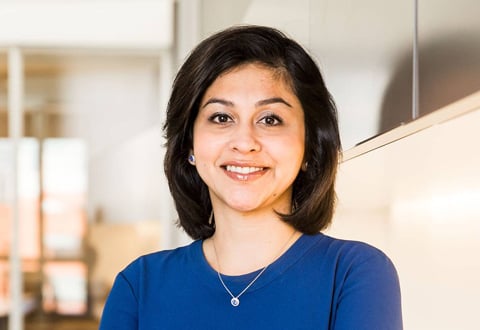 2. Neha Narkhede
2. Neha Narkhede
CS '07, Co-Founder and CTO of Confluent
As a software engineer for large social media network LinkedIn, Neha Narkhede helped develop Apache Kafka—an open-source, stream-processing software platform written in Scala and Java--to handle the networking site's huge influx of data. In 2014, she and two LinkedIn colleagues founded Palo Alto, Calif.-based Confluent to build tools for other companies such as Goldman Sachs, Netflix and Uber—using the Apache Kafka platform which had became open source three years earlier. Narkhede and her Confluent team raised $125 million in January 2019 from Sequoia Capital, bringing its total funding to $206 million. Thanks to her engineering know-how and entrepreneurial spirits, she now finds herself the chief technology officer—managing the engineering process—of a company that’s valued at $2.5 billion. Forbes Magazine ranked her No. 60 on its list of 2019 America’s Self-Made Women with a net worth of $360 million.
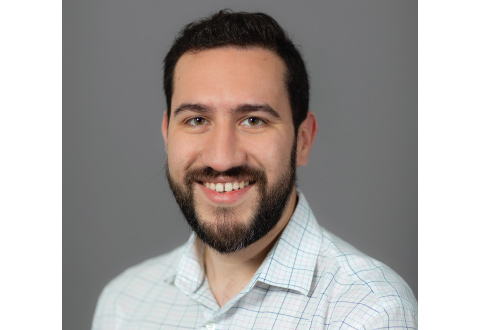 3. David Sotto
3. David Sotto
BME '09, PhD BME '15, Strategy Officer for the Gates Foundation
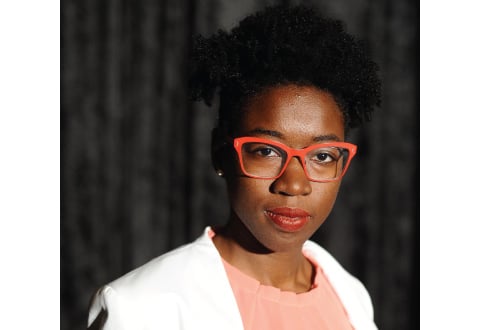 4. Joy Buolamwini
4. Joy Buolamwini
CS '12, Digital Activist and MIT Researcher
A self-styled poet of code, Joy Buolamwini uses art and research to illuminate the social implications of artificial intelligence (AI). Her research has uncovered large racial and gender bias in AI services from companies like Microsoft, IBM and Amazon, and she’s received a lot of attention internationally for her findings. She founded the Algorithmic Justice League to champion for ethical and inclusive technology, and she's stated her case at the World Economic Forum and the United Nations. Her TED Talk on algorithmic bias has over 1 million views. Describing her as “the conscience of the AI Revolution,” Fortune Magazine included her on its 2019 list of the world's greatest leaders.
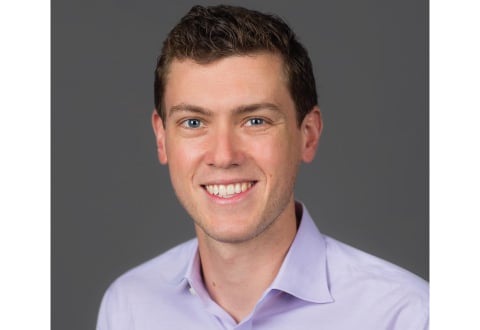 5. Garrett Langley
5. Garrett Langley
EE '09, Serial Entrepreneur and Founder and CEO of Flock Safety
Garrett Langley is an entrepreneur who strives to use technology to solve problems of everyday life. He spent the first 10 years of his career launching early stage companies across numerous industries, including banking, automotive, live events and sports, including Clutch, a monthly car subscription service for retailers and car owners, and Experience, a mobile technology company that helps companies enhance the live event experience for fans. Both companies were ultimately sold to Cox Enterprises. Most recently, Langley started Flock Safety as a solution for eliminating non-violent crime in residential neighborhoods after he personally experienced property crime at his home in Atlanta. After working with local police to understand how citizens can help prevent and solve crime, he and fellow Yellow Jacket Matt Feury, CS 11, started building the Flock Safety camera system. The duo was accepted into the competitive startup accelerator Y Combinator program in Silicon Valley and has raised more than $20 million in capital to make the community-based safety solution a reality. Langley remains very involved with the Georgia Tech community, and serves as an active member of both the Alumni Association board and the Athletic Association’s Alexander Tharpe Board.
 6. Anu Parvatiyar
6. Anu Parvatiyar
BME '09, CEO of Ethonova
Global health has been a passion of Anu Parvatiyar’s since she was an undergraduate student at Georgia Tech. She knew she wanted to study the intersection between public health and technology, and when she didn't find an existing avenue of study or research, she made her own. She harassed the biomedical engineering department to let her design and take an independent study course she called Design for the Developing World and 10 years later Parvatiyar would use that same research to write the business strategy for her medical device startup, Ethnova. The company designs, develops and distributes new forms of medical technologies and treatment to transform care in underserved markets around the globe. She believes that patients and doctors in the most remote areas cannot be served with the same designs, approaches and assumptions as those present in traditional medtech markets. Parvatiyar spent the first 10 years of her career conducting clinical research in Grady Hospital's trauma center, designing cardiac access ports for heart valve repair in Atlanta, overseeing plastics extrusion for medical devices in China, interviewing nurses about diagnostics in Singapore, building communications platforms for healthcare workers in Nigeria, and deploying software for polio eradication in Chad. She serves on the Alumni Association’s board of trustees and won its Outstanding Young Alumni Award in 2016.
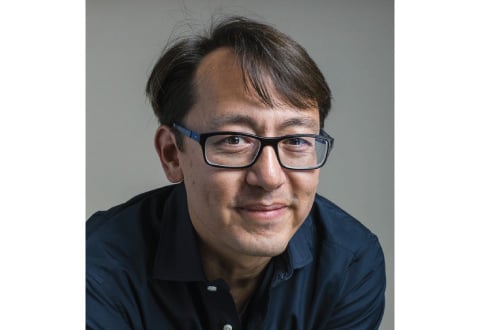 7. Ben Chestnut
7. Ben Chestnut
IE '98, Co-Founder and CEO of Mailchimp
With the mantra “listen hard, change fast,” Ben Chestnut found that while the splash of his web design agency Rocket Science Group and its large, corporate clients held a lot of promise, it was the more subtle, straightforward email marketing service he built on the side that proved to be the high-flying success he sought. Co-founders Chestnut and Dan Kurzius built up Atlanta-based Mailchamp as an alternative to the oversized and expensive email software that proliferated in the early 2000s. It did so well that in 2007, they closed the design agency and focused all their efforts on Mailchimp. Today, the company is one of the world’s top marketing platforms—it’s expanded far beyond just email—for small businesses around the globe, with over 1,000 employees and millions of users. Mailchimp was named company of the year by Inc. Magazine and recognized as one of the world’s Most Innovative Companies by Fast Company magazine.
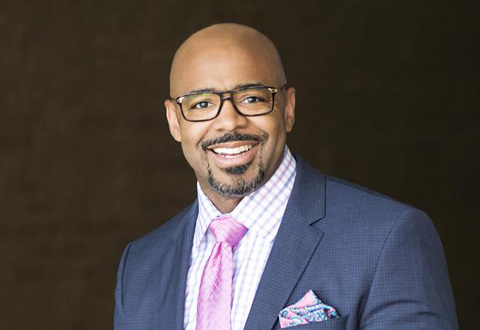 8. Kofi Smith
8. Kofi Smith
IE '99, MBA '09, President and CEO of the Atlanta Airlines Terminal Company
Kofi Smith has always moved well, from his maneuvers on the football field to his keen ability to make sound business decisions. The former Yellow Jackets defensive back finds himself front and center in an even bigger show now. Smith serves as president-CEO of the Atlanta Airlines Terminal Company (AATC), the private company that keeps the world’s busiest airport running. He and his team oversee the facility operations and building maintenance of some 7.2 million square feet of the passenger terminal complex at Hartsfield-Jackson International Airport, serving the airport’s 55,000 employees and more than 100 million passengers annually. Smith has won numerous awards, including being named one of Atlanta’s Most Admired CEOs by the Atlanta Business Chronicle.
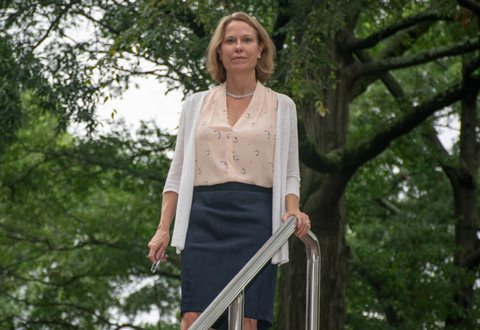 9. Diana Alleva Caceres
9. Diana Alleva Caceres
PhD IA '15, CEO of Market Access International and Presdient of World Trade Center Atlanta
Diane Alleva Cáceres had a chance to start working on her doctorate straight out of college. Instead, she embarked on a career in international trade and investment, building connections all around the world before finally settling in Atlanta and choosing the Sam Nunn School of International Affairs to pursue an advanced degree. Now, Cáceres is a lecturer at the Nunn School, the CEO of Market Access International—an international trade and investment consulting firm—and the president of World Trade Center Atlanta. On top of that, the longtime elected member of the Council on Foreign Relations recently was awarded an International Affairs Fellowship in Canada by the organization. When she leaves for the 6- to 12-month assignment, she will be based part-time at the Institute for Research on Public Policy in Montreal, and will examine the nexus of science, technology, international trade and investment within the U.S.-Canada relationship.
 10. Brianna Cochran
10. Brianna Cochran
IE '18, Fulbright Scholar and Startup Entrepreneur
Places
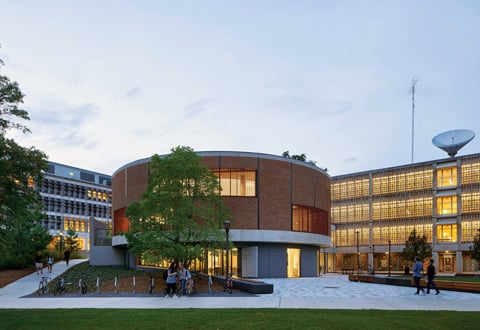 1. Van Leer Interdisciplinary Design Commons & Makerspace
1. Van Leer Interdisciplinary Design Commons & Makerspace
Opened in the fall of 2018 as part of an $11 million redesign of the Van Leer Building, the Interdisciplinary Design Commons is a 15,000-square-foot, state-of-the-art makerspace—the largest of its kind in the nation—that caters specifically to electronics and computer engineering design and innovation. However, students of all majors can use the IDC, which like other makerspaces on campus offers them a hands-on learning environment where they can work together to solve technology design challenges. The IDC sprawls across three floors, with each featuring a different focus. The first floor includes a woodshop, a host of 3D printers, laser cutters and a plasma cutter, while the second hosts lab benches equipped with function generators, multimeters, power supplies, soldering irons and additional benchtop equipment. The third floor features computers and embedded systems equipment, as well as a student lounge area. What’s particularly cool about the IDC is that it’s manned by Tech students through the campus organization known as The Hive. They’re trained as peer instructors to operate all of the IDC equipment and help fellow Yellow Jackets work on their projects.
 2. Brittain Dining Hall
2. Brittain Dining Hall
Harry Potter had the Great Hall at Hogwarts, but Tech students have Brittain Dining Hall. Since its construction in 1928, the Marion L. Brittain Dining Hall has been the source of much nostalgia for Ramblin’ Wrecks and interest from outsiders. The red brick building, with its limestone trim, Doric pillars, lofty ceilings and gorgeous stained glass windows, was once named “the South’s most stunning college dining hall” by Southern Living magazine. The creation of the building was a joint effort by many of Tech's departments: The architecture department designed the building, the ceramics department manufactured the tile for the floor of the tower, the mechanical engineering department supplied the wrought iron for the light fixtures in the main hall and the textile department made tapestries for the walls. It’s been restored and updated four times over the decades. And although the building has been visited by thousands of students, it still holds a secret most don’t know: There’s a small apartment above the dining room that was occupied by Daisy Daniels, the dining hall’s supervisor starting in 1938.
 3. GTRI Compact Radar Range
3. GTRI Compact Radar Range
Call it the Blue Room. The Georgia Tech Research Institute (GTRI) operates an indoor compact range used for radar cross section measurements and antenna testing. The facility is shielded against electromagnetic interference and used for both internal research and collaborations with industry. The range is 18 feet high, 24 feet wide, and 60 feet long. It can test at frequencies ranging from two gigahertz to 100 gigahertz, and that range can be extended down to 200 megahertz to accommodate UHF antenna testing. Shown under test here is a Skywalker X8 airframe that was being used as a test bed for swarming UAV research. The aircraft is undergoing antenna pattern characterization as part of an investigation into inter-aircraft communications.
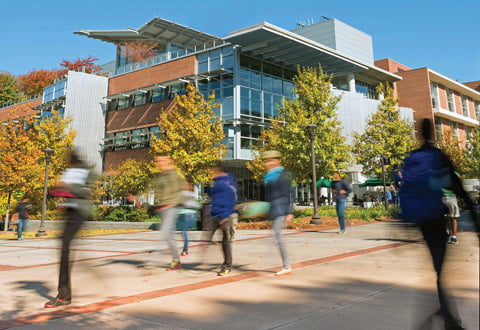 4. Clough Undergraduate Learning Commons
4. Clough Undergraduate Learning Commons
The five-story, 222,000-square-foot Clough Undergraduate Learning Commons—most commonly called just Clough—is one of Tech’s main hubs of activity throughout the school week. Since it opened in the fall of 2011, it’s housed classrooms, labs, an art gallery, academic services and student commons areas, and most importantly for some, a Starbucks. Named for the Institute’s beloved President Emeritus G. Wayne Clough, the building was designed to support collaborative learning, scientific instruction and undergraduate life right at the heart of campus. It’s a modern, open and inviting space with sustainable functionality at its LEED-certified core. Clough Commons’s 18,000-square-foot rooftop garden is teeming with native plants and spaces to sit—and it makes for a lovely place to study or hang out on most days. Hundreds of solar panels help generate electricity for the building, and Clough uses reclaimed rainwater from a 1.4-million-gallon cistern located underneath nearby Tech Green to irrigate the landscape and flush toilets.
 5. Autonomous Racing Facility
5. Autonomous Racing Facility
At the Georgia Tech Research Institute (GTRI) Cobb County Research Facility—some 12 miles north of main campus—resides an unassuming, seemingly simple, dirt test track. At what’s known as the Georgia Tech Autonomous Racing Facility, faculty and students from the School of Interactive Computing and the Daniel Guggenheim School of Aerospace Engineering routinely conduct cutting-edge research that could impact the future of transportation. They’ve programmed one-fifth-scale autonomous cars to race, slide and jump at the equivalent of 90 mph. The goal is to develop maneuvering techniques that can keep self-driving vehicles on the road and their occupants safe. Many futurists envision commuters napping through drive-time, high-speed convoys of networked big-rigs, and a huge drop in accidents as robotic vehicles take over from impaired and distracted humans. Tech is helping to make what once seemed like science fiction a modern-day reality.
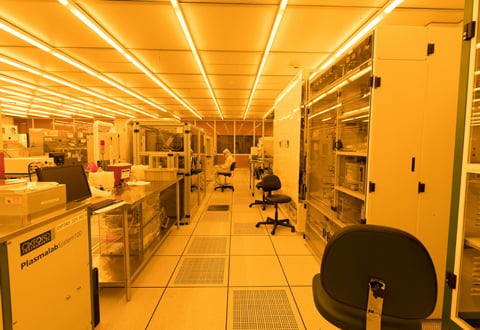 6. The Nanotechnology Cleanroom
6. The Nanotechnology Cleanroom
The Marcus Nanotechnology Building not only is the headquarters for the Institute of Electronics and Nanotechnology, but also it’s home to the largest cleanroom laboratory dedicated to the fabrication, characterization and assembly of biomedical and semiconductor devices in the Southeast United States. There’s a total of 15,000 square feet of space—10,000 dedicated to semiconductor work and 5,000 for biological use. Much of the equipment in the cleanroom is custom built, including one of only about 100 specialized electron beam lithography machines in the world. Nanotechnology fabrication and assembly demands the best systems for keeping out contaminants—even the smallest mote of dust can cause problems. So that’s why everyone entering the cleanroom must begin in a dedicated gowning area to suit up in what seems like an excessive amount of coveralls, hair nets, hoods, shoe covers, boots, safety goggles and rubber gloves.
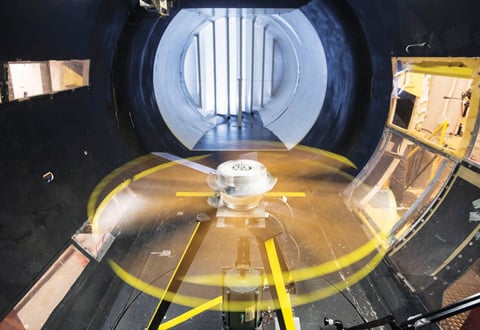 7. The John J. Harper Wind Tunnel
7. The John J. Harper Wind Tunnel
Located on the ground floor of the Daniel Guggenheim School of Aerospace Engineering’s Guggenheim Building, the low-speed wind tunnel is a state-of-the-art facility for experimental research. Over the years, aerospace researchers have used this laboratory to test and/or develop a wide range of products including radar antennae, stadium lights, laser scanners for cash registers, delta wings, rotor blades, business jets, fighter planes, the NASA X-38 Crew Return Vehicle, parafoils and the soil scoop arm for NASA’s Curiosity Mars Rover. Five awards under the highly competitive Defense University Research Instrumentation Program, among other projects, have kept the tunnel at the leading edge of diagnostics capabilities for basic research. The wind tunnel operates entirely on sponsored research projects. These have included studies to improve the speed and safety of carrying slung loads under helicopters, to enable helicopter flight at high speeds, and understand fin vibrations on fighter planes at a high angle of attack, as well as a NASA project to improve the ability of future aerospace engineers to learn to innovate across several disciplines.
 8. Technology Sqaure
8. Technology Sqaure
Who needs Silicon Valley? Located in Midtown Atlanta, Tech Square boasts the highest density of startups, corporate innovators and academic researchers in the entire southeastern United States. It’s a thriving ecosystem and community that spurs creativity and interaction among entrepreneurs, researchers, laboratories, venture capitalists, established multinational companies, Georgia Tech students and faculty. Opened in 2003 to foster a better connection between the Institute and Atlanta’s business sector, Tech Square has grown in size (about 10 blocks total) and reach (hosting more than 20 corporate innovation centers from major companies and a total of nearly 20,000 employees). The recently opened Coda building and data center for high-performance computing added 750,000 square feet of mixed-use capacity, creating even more opportunities for interdisciplinary research, commercialization and sustainability. Phase III for Tech Square is already underway on the northwest corner of West Peachtree Street and Fifth Street. It will include the new Scheller Tower (scheduled to be opened in 2022) and extend the footprint of the Ernest Scheller Jr. College of Business to house its MBA and executive education programs. An additional tower will be dedicated to the H. Milton Stewart School of Industrial Systems Engineering and other programs.
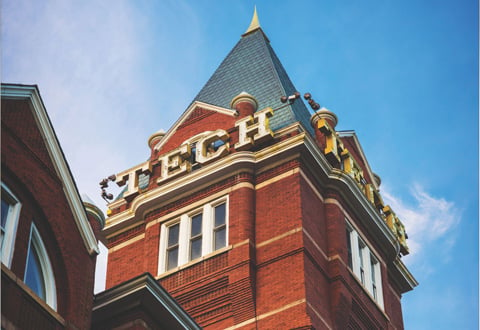 9. Tech Tower
9. Tech Tower
The most recognizable landmark of the Institute, Tech Tower has soared over the center of campus—with much thanks to the hill on which it’s perched—since its completion in 1888, making it Georgia Tech’s oldest building. Originally constructed as the Administration Building, the tower itself rises three floors above the main structure, which houses four floors and a basement. It’s made of red brick, trimmed with granite, and sports a gabled, copper-shingle roof (originally terra cotta). The letters that spell out T-E-C-H on each side of the top of the tower, installed by Tech’s class of 1922, provided the edifice with its nickname. Light bulbs were added to the letters in the 1930s. Today, Tech Tower is officially known as the Lettie Pate Whitehead Evans Administration Building, named after one of the Institute’s most generous benefactors. The building currently houses the Registrar’s Office, the College of Engineering Dean’s Office and the College of Sciences Dean’s Office, among others.
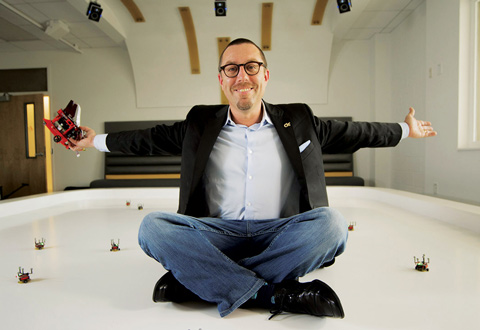 10. The Robotarium
10. The Robotarium
Funded by a $2.5 million grant from the National Science Foundation and the Office of Naval Research, the high-tech Robotarium is a 725-square-foot-facility located in Georgia Tech’s Van Leer Building (Room 261, to be precise). However, you need never step foot in this leading-edge lab to use it. The Robotarium houses nearly 100 rolling and flying swarm robots that are accessible to virtually anyone from anywhere across the globe. Remote researchers can write their own computer programs, upload them and then see the results as the Georgia Tech small robots carry out their commands from afar. The Robotarium is the brainchild of Magnus Egerstedt (pictured below), the Steve W. Chaddick Chair and professor in the School of Electrical and Computer Engineering, and his team of researchers at Tech. Egerstedt says the concept behind the facility is simple: robots for everyone. This type of research is often prohibitively expensive and requiring significant investments in manpower and resources. However, the Robotarium opens up these doors to anyone with new ideas they want to test out on real robots rather than through mere simulations.
Teachers
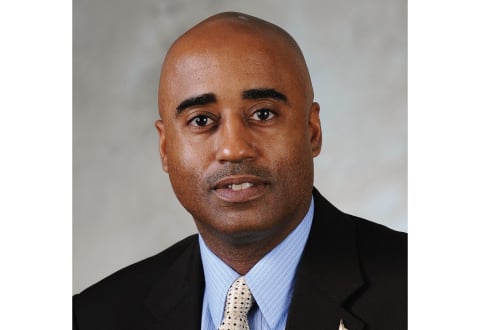 1. Stephen Ruffin
1. Stephen Ruffin
Associate Professor of Aerospace Engineering and Director of the Georgia Space Grant Consortium
Long a proponent of STEM education in K-12 schools, Stephen Ruffin strives to make sure everyone has access to resources for success. The son of two science professors, he grew up fascinated by the NASA space program, but wasn’t always encouraged by everyone. “When I was in high school a guidance counselor asked me where I was going to apply for college. I said 'Princeton, MIT, and Georgia Tech',” he recalls. The counselor told him be needed to be more realistic. Realistic? He wound up attending two of those schools and teaching at the third. As a faculty member at Tech and the director of the NASA-funded Georgia Space Grant Consortium, Ruffin works tirelessly to provide opportunities to all who seek to study space and other STEM subjects. The consortium helps train K-12 STEM teachers and, at Tech, it has funded fellowships, prepared mentors, performed outreach and even supported the work of the Ramblin’ Rockets Club.
 2. Johnny Smith
2. Johnny Smith
Professor of Sports History
Professional sports may have the veneer of a carefree diversion, but Johnny Smith recognizes them for what they are: a telling reflection of the cultural and political fault lines of their times. As the Julius C. "Bud" Shaw Professor of Sports History in the School of History and Sociology, Smith specializes in the history of sports and American culture. In his celebrated books, he has examined the relationship between Muhammad Ali and Malcolm X, Mickey Mantle’s ascendancy as the ideal post-WWII icon in the 1950s and UCLA’s basketball dynasty in the context of political conflicts of college athletics in the 1960s and 1970s. His astute insights have twice earned him the Journal of Sport History's Best Article Award as well as the Ivan Allen College Teacher of the Year Award and recognition as a Distinguished Lecturer by the Organization of American Historians.
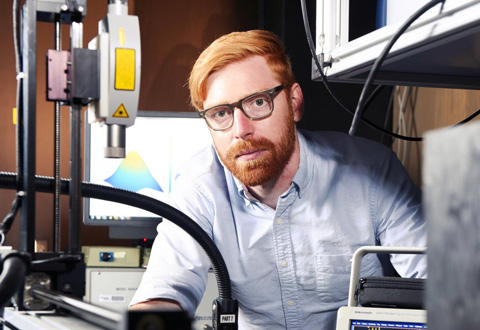 3. David Torello
3. David Torello
ME '13, PhD ME '13, Woodruff Teaching Fellow
At heart, David Torello is a maker. So it’s no surprise in his role as a Woodruff School of Mechnical Engineering Teaching Fellow that he emphasizes hands-on instruction and real-world, problem-solving skills. The Tech alum specializes in non-destructive evaluation, which has endless real-world applications in enabling engineers to prevent structural failure before it happens and determine where a material is in its total engineering life. As the faculty mentor of the A. James Clark Scholars Program at Georgia Tech, Torello works with an exceptionally bright and talented cohort of students from the start of their engineering life. He serves as an essential resource for these outstanding students throughout their academic career at Tech as they hone not only their technical expertise, but also their service contributions and leadership skills.
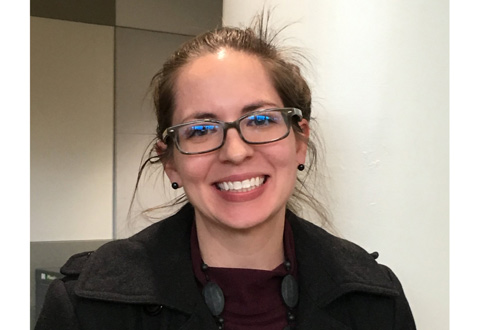 4. Emily Weigel
4. Emily Weigel
PhD BIO '10, Academic Professional in Biological Sciences
As an ecologist, Emily Weigel seeks to understand how individuals are shaped by their environment. It’s a perspective that informs and enriches her courses in the School of Biological Sciences and her role as an academic advisor. It also led to her winning both the 2019 Undergraduate Educator Award and Undergraduate Academic Advising Award. Weigel’s selection as a University System of Georgia Scholarship of Teaching and Learning (SoTL) Fellow gave her the opportunity to design and develop a classroom-based research project and sharpen analytical skills to then pass along to her students and advisees. Her engagement with her students is evident in such courses as “Extreme Atlanta,” an interdisciplinary examination of local environmental changes and their impact on organisms (including humans), and how they are tied to global climate change. She is equally engaged with her advisees, responding to calls for assistance after hours and empowering them to succeed on campus and in the working world.
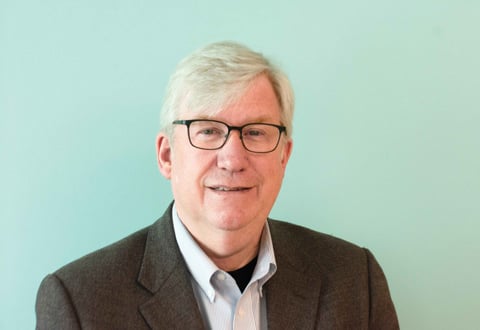 5. Keith McGreggor
5. Keith McGreggor
BS CS '82, MS CS '87, PhD CS '13, Director of Venturelab
As a lifelong entrepreneur with more than 10 startups under his belt, creating startups is his forte. While his research and teaching focus in the College of Computing and Scheller College of Business as a professor of the practice is on cognitive science, artificial intelligence, and entrepreneurship, Keith McGreggor also leads his team at VentureLab, Georgia Tech’s comprehensive center for technology commercialization, which is open to all faculty, research staff, and students who want to form startups based upon their research. VentureLab transforms those innovations into startups by developing engaging business models, connecting researchers with experienced entrepreneurs, locating sources of early-stage financing, and preparing these new companies for global markets. With more than 500 active startups based on Tech’s technology and more than $1.9 billion in capital raised, under Keith’s leadership, VentureLab has been consistently ranked as one of North America’s top 10 university-based incubators. McGreggor also is the executive director and lead instructor of the NSF’s I-Corps South program, which provides entrepreneurial training and commercialization assistance to research universities throughout the South.
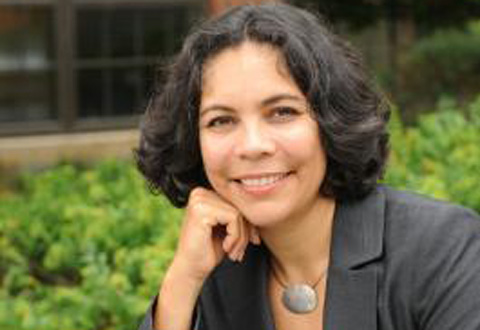 6. Jennifer Singh
6. Jennifer Singh
Associate Professor of History and Sociology
As the winner of Georgia Tech’s 2019 Serve-Learn-Sustain Award for Excellence in Community-Engaged Sustainability Teaching, Jennifer Singh works to shape her students trajectories by the approaches she takes in the classroom. Courses like “Health Inequalities” and “The Sociology of Medicine and Health” challenge students to think beyond merely reading about social determinants of health and instead directly interact with the communities around them. She exposes them to real-life examples of inequality and develops their analytical skills via class projects that enlist community partners as their clients. One of her students, Olivia Rea, says that because of Singh, she “became much more aware of the greater Atlanta community and the resources students and faculty alike possessed to make a positive impact beyond the borders of campus.” Rea now volunteers regularly in a program that supports Atlanta Public School students. Singh’s goal is to get her students to realize their place and the part they can play in the greater society as a healthier, more aware individual.
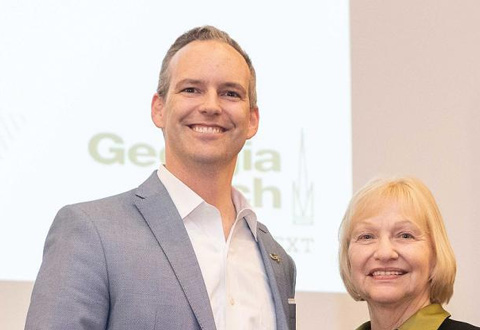 7. James K. Rains
7. James K. Rains
Professor of the Practice, Biomedical Engineering
Since joining the faculty in 2012, James Rains has taught two of Tech’s most critical classes for creating the next generation of biomedical engineers. “Intro to Biomedical Engineering Design” and the “Biomedical Engineering Capstone” courses are bookends on the student experience in the BME program, which has consistently ranked among the best in the nation. Meanwhile, Rains helps give students more real-world healthcare problems from clinicians and medical companies than any other BME department in the world. He constantly strives to find the best and most diverse projects for his students, including in 2018, a new collaboration with the world-renowned Mayo Clinic. His BME student teams consistently win top honors in innovation competitions and mentors and coaches Create-X student startups. For all of his tremendous efforts, he was named the 2019 Undergraduate Educator of the Year by Tech’s Center for Teaching and Learning.
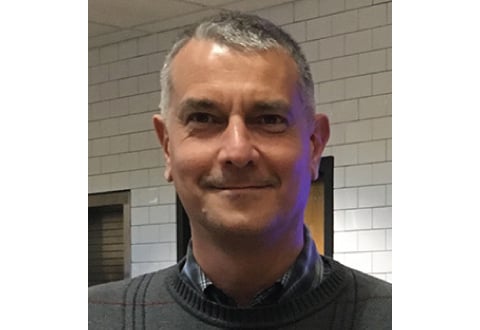 8. Plamen Iliev
8. Plamen Iliev
Professor of Mathematics
Whatever the subject, accolades from students are profuse about Plamen Iliev’s effectiveness as a teacher: “Best math teacher I’ve ever had.... Ten thumbs up!” “If I could have him for as a teacher for all my courses, it would be great.” “He always made his expectations very clear and always announced what he planned to teach us next. He cared very much whether or not students learned material.” “He knows his stuff backwards and forward.” “An amazing lecturer. Comes to class with no notes and somehow delivers extremely relevant examples.” Since joining Georgia Tech in 2003, Iliev has taught large, lectures such as Calculus I, II and III, Differential Equations, and Multivariable Calculus, as well as core graduate courses, to more than 3,000 students. His tried-and-true approach to teaching has made a broad impact on undergraduate education and has provided solid foundational training for graduate students. Iliev cares about his students, has high expectations of them, and has a track record of being effective and engaging. In fact, he won the prestigious 2019 Geoffrey G. Eichholz Faculty Teaching Award by Tech’s Center for Teaching and Learning for continued excellence.
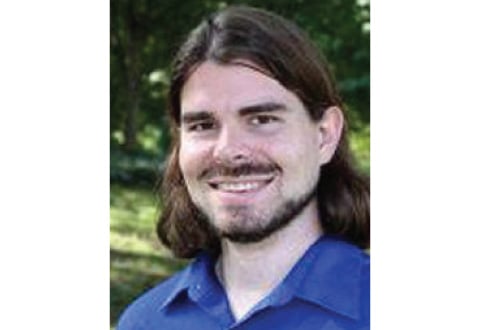 9. David MacNair
9. David MacNair
Director of Laboratory Development, Mechanical Engineering
A little more than four years ago, David MacNair took on the challenge of redesigning the instructional laboratories in the Woodruff School of Mechanical Engineering. He applied learning theory and evidence-based learning techniques to re-imagine the laboratory experience for Tech students. He created new laboratory platforms for them to use, and designed and produced data-collection equipment and pieces of experimental apparatus to help them navigate their work in labs more easily. MacNair also fundamentally improved the quality of the content by covering fewer topics but diving into far greater depth. Not only did he innovate the learning process, but he also prepared these students for the realities of engineering in the world beyond Tech. Finally, he worked closely train teaching assistants to ask the right questions to guide students to the answers and how to build better instructor-student relationships. Mechanical engineering students in his laboratories widely laud him for his efforts to make them better learners and, ultimately, better engineers.
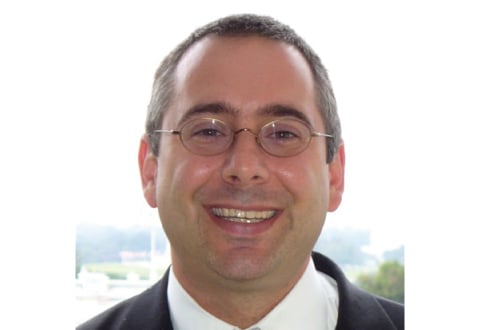 10. Robert Butera
10. Robert Butera
Associate Dean for Research and Innovation
It’s hard to pin down the impact that Robert Butera has made at Georgia Tech. Not only is he an associate dean, but he also is a professor of biomedical engineering and electrical and computer engineering. Certainly, he’s strong in research, having directed the Neural Engineering Center for three years, bringing interdisciplinary minds from across campus together. Yet Butera is remembered by most students for his teaching and care. In his lab, where young researchers learned about the intersection of engineering and neurology under his watch and developed skills in intracellular and extracellular electrophysiology, computational modeling and real-time computing. In recognition for his teaching and overall impact, he was given the 2019 ANAK Award, given annually to a faculty member who has demonstrated outstanding service to the Institute and to the student body.
Pro Athletes
 1. Josh Okogie
1. Josh Okogie
CLS '20, Gaurd, NBA, Minnesota Timberwolves
Josh Okogie was not even 3 years old when his parents, Pius and Anthonia Okogie, won the lottery—the U.S. State Department lottery for green cards to move from Nigeria to the U.S. As a result of their good fortune, young Okogie developed an early passion for basketball, one of America’s signature sports. When Okogie was a middle-schooler in Snellville, Georgia, he would wake up at 5 a.m. to dribble, shoot, and work with a trainer before class. Despite his dedication, Okogie was not a highly touted high school player, not even ranked by ESPN in their list of top 2016 recruits. He received only one major college offer, from nearby Georgia Tech. Undeterred, Okogie immediately cashed in on the opportunity, averaging more than 16 points and 5 rebounds as a freshman shooting guard for the Yellow Jackets, earning a spot on the Atlantic Coast Conference All-Freshman Team. Barely a year later, in June 2018, Okogie and his parents were guests of honor at an NBA Draft watch party in Midtown Atlanta. There, via the broadcast projected on the big screen at the front of the room, Okogie’s name was announced as the first-round pick of the Minnesota Timberwolves, the 20th overall selection of the draft—not quite a lottery pick. Of course, Okogie has learned there’s much more to success than just luck of the draw.
 2. Shaquille "Shaq" Mason
2. Shaquille "Shaq" Mason
CLS '15, Offensive Guard, NFL, New England Patriots
It’s become a cliché that most students, let alone student-athletes, prefer to sit in the back of the classroom, far from the lecturer’s monitoring gaze. But not Shaq Mason. Tech professors remember the 300-pound All-American offensive lineman sitting front-row and center, at full attention during their classes. It makes sense when you consider that Mason’s job on the gridiron is to be on the front lines, blowing holes in the defense for running backs and protecting the quarterback. Mason started 39 of 41 games for the Yellow Jackets in his last three years (2012–2014), including every game his junior and senior years, earning first-team All-ACC in 2013 and 2014 and first-team All-American in 2014. He was drafted by the Patriots in the fourth round of the 2015 NFL Draft to help guard future Hall-of-Famer Tom Brady en route to three Super Bowls. Mason works for more than just the glory and recognition. During the summer before his senior year at Tech, his girlfriend gave birth to a baby girl, Kamrie. From that moment on, Mason had the only reason he needed to show up for work every day.
 3. Charlie Blackmon
3. Charlie Blackmon
BA '11, Right Fielder, MLB, Colorado Rockies
Most people recognize Charlie Blackmon, nicknamed “Chuck Nazty,” for his long, scraggly black beard and a smooth left-handed power swing that has made him a four-time Major League Baseball All-Star outfielder. Less well known is that just two years at Georgia Tech forever altered the course of his career. When Tech recruited Blackmon as a junior-college transfer in 2006, it was as a standout pitcher with more strikeouts than innings pitched. But before his first season as a Yellow Jacket had gotten underway, Blackmon developed tendinitis in his throwing elbow, forcing him to redshirt. Tech coach Danny Hall decided to let Blackmon transition to the outfield, a move that paid off mightily for both the team and the future major-leaguer. When discussing his success in professional sports, Blackmon is quick to credit his experience on Georgia Tech's campus, where he studied business and graduated with highest honors, almost as much as that at Russ Chandler Stadium. “Tech was challenging for a lot of reasons,” he told the Alumni Magazine in 2017. “There are big classes. And there’s so much work done outside of class. You’re really challenged to find out how you learn best. All those things can be applied to the game of baseball.”
 4. Christopher Eubanks
4. Christopher Eubanks
CLS '18, Tennis Player, ATP Tour
Christopher Eubanks learned a lot as a business major and student athlete at Georgia Tech—but not much about failure. He was a two-time ACC Men’s Tennis Player of the Year, an Intercollegiate Tennis Association All-American, he won the 2017 National Division I ITA/Arthur Ashe Leadership and Sportsmanship Award, and spent two solid years ranked among the top 10 men’s collegiate players in the country.Since Eubanks passed up his senior year at Tech to turn pro, the accolades have been a bit slower to come. He is currently ranked No. 188 in the world, with a career record of just 2-6 at the professional level. But he’s only 23, and he’s already had a professional breakthrough, advancing to the quarterfinals of the 2017 BB&T Atlanta Open, and he qualified for the 2017 U.S. Open and the 2019 Australian Open. And his blistering serve recently earned him a spot among the Tennis Channel’s “10 to Watch.” Fortunately, attending Tech prepared Eubanks for the long haul. “Balancing being a student-athlete here is definitely difficult. (There’s no getting around that),” he told the Alumni Magazine in 2017. “But if there’s something Tech has taught me, it’s patience.”
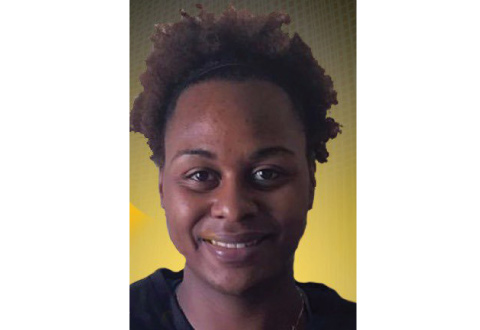 5. Sasha Goodlett
5. Sasha Goodlett
HTS '12, Center, Turkish, Pro Basketball League, Cankaya Universitei Ankara
As a 6-foot-5, 200-plus-pound force in the paint and Mississippi state high school basketball champion for the Clinton Lady Arrows, Sasha Goodlett could’ve come to college expecting stardom from tip-off of her freshman year. But when she arrived at Georgia Tech in the fall of 2008, she quickly learned that nothing was guaranteed. “Everything [coach MaChelle Joseph] was saying was, ‘You’re not going to come here and start,’” Goodlett told the Alumni Magazine in 2012. “‘You’re going to have to earn it.’” Newly motivated, Goodlett did a great deal more than that, finishing her Tech career 10th all-time in points scored (1,364, including a whopping 506 in her senior year alone), 9th in rebounds (760), and fifth in shots blocked (127), and leading the Jackets to their first-ever NCAA Tournament Sweet 16. She was selected by the Indiana Fever as the 11th overall pick in the 2012 WNBA Draft. As a rookie, she would go on to help the team win its first WNBA Championship that year. Like many American basketballers, Goodlett is now playing professionally in Europe, where she has won four more championships. Last year, she averaged a double-double (25.8 points per game; 11.6 rebounds) for Cankaya Universitei Ankara in Turkey. But overseas, most contracts are given out on a year-by-year basis. Next season is never guaranteed. Goodlett knows she’ll have to earn it.
 6. Matt Kuchar
6. Matt Kuchar
Mgt '00, Golfer, PGA Tour
Though he was born and raised in Florida, Matt Kuchar came to Georgia Tech and found his second home. Here, he met his future wife, Sybi (Mgt 99). And it was on the greens and fairways of Atlanta where he honed the swing that would make him one of the world’s most successful professional golfers. Since he turned pro in 2000, Kuchar has won 14 wins, 9 of them PGA Tour events, including the 2012 Players Championship, the tour’s flagship tournament. In 2010, he won the Vardon Trophy with the tour’s leading scoring average, and that year he was also the tour’s leading money winner. In Rio 2016, he won the first Olympic bronze medal given to a golfer since the 1904 Summer Olympics, and he has been tabbed as high as No. 2 in the FedExCup rankings. Kuchar finished last season with more career winnings (nearly $50 million) than any other golfer in history without a major championship. Kuchar has taken a chunk of those winnings and put it right back into his adopted home. He and his wife host an annual Camp Twin Lakes Golf Tournament, which has raised more than $1.7 million to help provide a fully accessible summer-camp experience for thousands of Georgia children who have serious illness, disabilities, or other life challenges.
 7. Jeanine Williams
7. Jeanine Williams
Biochemistry Student, Track and Field, Jamaica
Life is full of hurdles. For Jeanine Williams, the first major obstacle was being a wildly athletic youth going to a small Jamaican high school where opportunities were limited. She played every sport she could find, but it eventually came down to track… and dance. Ever self-reliant, Williams chose to run. The decision paid off with an opportunity to go to school at Auburn University, but she didn’t fit in there. Her high school coach then put her in touch with Nat Page, hurdles coach at Tech, where she felt more at home and she made the leap. Both parties benefitted greatly as she went on to represent the school as an 2018 NCAA All-American in both indoor and outdoor track. Williams runs the 60-, 100-, and 200-meter, as well as the 4X100 meter relays. But her forte is, naturally, the hurdles, where in 2019 alone, she wound up on the podium after 21 of 24 races, including 14 first-place finishes. After using up her remaning athletic eligibility last year (she's still finishing up her studies in biochemistry), her goal is to turn pro and represent her native Jamaica in the 2020 Summer Olympics in Tokyo. After that, she also eventually wants to go to medical school to become a pediatric surgeon—high bars that Williams feels confident she can surmount.
 8. Roman Reigns
8. Roman Reigns
CLS '07, Professional Wrestler, WWE
When Joe Anoai left Georgia Tech 12 years ago, he probably couldn’t have imagined what his life was to become. At the time, he was a first-team All-ACC defensive tackle his senior year before taking his dreams to the 2007 NFL Draft. Unfortunately, he went undrafted and signed with Minnesota Vikings, who released him later that month. He was picked up by the Jacksonville Jaguars, promptly let go, and found himself in the Canadian Football League, where he lasted just a year. On top of all this, Anoai was battling leukemia. But he was hardly beaten. He battled his leukemia into remission and then he decided to fall back on the family business—pro wrestling. So Anoai traded his cleats for wrestling boots and climbed into the ring as Roman Reigns, a fan-favorite face (good guy) and heel (bad guy) who has held just about every championship in the sport, including the WWE Championship three times and pinnacle Universal Championship once. The Roman Empire was only brought down by a return of Anoai’s leukemia, which forced him to temporarily leave the ring. He has since returned, both to the WWE and now, to join fellow wrestlers like Dwayne “The Rock” Johnson and John Cena as a big-screen action hero. He starred alongside Johnson in this summer's Hobbs and Shaw. The role was one he was well prepared for, both physically and mentally.
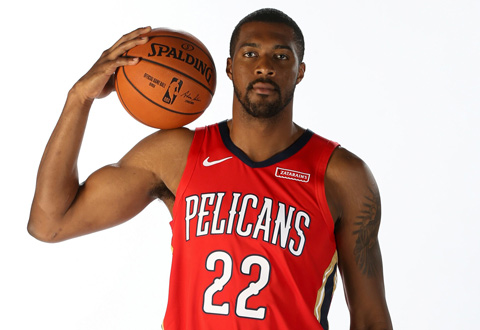 9. Derrick Favors
9. Derrick Favors
CLS '13, Power Forward, NBA, New Orleans Pelicans
Derrick Favors’s time at Tech was brief, but he certainly made the most of it. As a freshman during the 2009–10 season, he was second on the team in scoring (12.4 points per game) and rebounds (8.4), and was named ACC Rookie of the Year, while leading the Yellow Jackets to the conference championship game and the second round of the NCAA Tournament. But following that stellar debut, most experts projected Favors would be a Top 5 NBA Draft Pick, and the lure of The League was too great. He declared for the draft, left Tech, and was picked third overall by the New Jersey Nets, where he earned NBA All-Rookie Second Team honors in 2011. Favors has developed into a solid NBA veteran over 9 seasons spent with the Nets and then the Utah Jazz, where he’s averaged 12.1 points per game and 7.4 rebounds, helping the Jazz to three straight playoff berths before being traded to New Orleans this past offseason.
 10. Annika Rowland and Teegan Van Gunst
10. Annika Rowland and Teegan Van Gunst
ME '17 and ME '17, Beach Volleyball, AVP Tour
Teams facing off against the Yellow Jackets women’s volleyball team between 2013 and 2016 might have thought they were seeing their doom in double-vision. But it was just the Van Gunst twins dominating their side of the net. Over their four-year careers at Tech, middle blocker Annika Van Gunst Rowland and outside hitter Teegan Van Gunst each compiled more than 1,000 kills and 1,000 digs on the O’Keefe gym hardwood. Teegan was all-ACC first-team twice and played for Team USA at the 2017 University Games in Taipei; Annika made the ACC academic honor roll four times. Both received mechanical engineering degrees. And then they decided to hit the beach. After a year playing collegiate beach volleyball across town at Georgia State, where they both earned their MBAs, they took to the sand full-time as part of the Association of Volleyball Professionals (AVP) Tour. It was their first season as pro athletes. But after the summer ended, it was back to work for the sisters, so they can save up enough to hit the tour again next year (AVP teams generally pay their own way). Since their father and two brothers all have engineering degrees too, they’ve joked that with their newfound business acumen, they just might have to start a family business.
Students
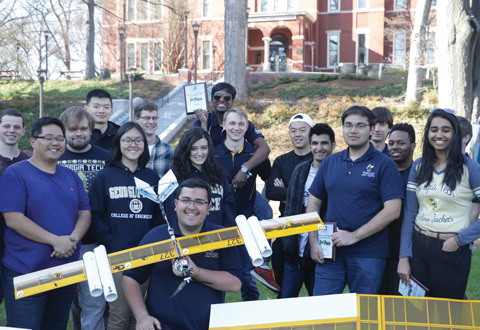 1. Ogun Kargin
1. Ogun Kargin
AE '19, Graduate Student in Aerospace Engineering
The future of airplane design may one day be determined by Tech international graduate student Ogun Kargin. A native of Turkey, Kargin earned his bachelor’s degree in aerospace engineering this summer and is pursuing his master’s degree at the Institute to hone his skills. For the past four years, Kargin has been heavily involved with the Georgia Tech Design/Build/Fly Club—which builds model aircraft—and has led his teams to multiple international competitions and helped carry the Institute to the podium each and every time. But his head is not always in the clouds. Kargin recently participated in the Oxford Study Abroad Program and he’s long been involved in the Student Alumni Association, serving as a graduate student liaison. Blue skies continue to loom for Kargin, who has co-oped with Boeing and hopes to one day get to fly an airplane of his own design.
 2. Chloe Kiernicki
2. Chloe Kiernicki
Architecture Student
This past summer, undergraduate architecture student Chloe Kiernicki interned with the provincial government in Guangzhou, China, where she researched vernacular architecture in the region and investigated how traditional methods of building and design addressed the humid climate. But this was far from her first international experience as a student at Georgia Tech—Kiernicki has also studied social entrepreneurship in Eastern Europe and learned about sustainable development in Japan. This fall semester, she joined the Digital Fabrication Lab where she’s part of a team (called Re-Wind) that is researching ways to reuse wind turbine blades in artistic and functional manners after their end of life. It’s the perfect opportunity for her to pursue her passions of public art, sustainability and architecture. Kiernicki has been an active member of the Georgia Tech Student Foundation since her freshman year, and she’s been instrumental in building student awareness about the importance of investments and philanthropy. She’s personally paid her good fortunes forward as a former intern with the City of Atlanta, working with the Department of Urban Agriculture in community design and engagement.
 3. Daughtry St. John
3. Daughtry St. John
Neuroscience Student
She’s wanted to be a physician since age 4, and Daughtry St. John has gone above and beyond since to put herself on the path to becoming a doctor. Not only has she taken all the right college classes—biology, chemistry, psychology—she’s also worked in a medical clinic in her hometown of Columbus, Ga. This past summer, she also earned her EMT certification through Grady Hospital’s accelerated program which guided students through a 5-month program in just 6 weeks. She worked clinical shifts in Grady’s Level 1 trauma center in the heart of downtown Atlanta. “It was intense, to say the least,” St. John says. “I had never witnessed real trauma, medical crises or even deaths.” She came out shaken by these experiences, but even more convinced to help people. At Tech, her curiosity has led her to research the underlying cell and molecular processes of the brain and how they affect behavior. She’s participated in research in both the biomedical engineering and psychology departments, and now is engaged in her neuroscience capstone class. Somehow St. John has also made time to serve as a Student Ambassador and co-found the Precious Angel Project, which organizes volunteer visits to nursing homes.
 4. Diana Toro
4. Diana Toro
Biochemistry Student
Soon after Diana Toro started volunteering for Hands On Atlanta’s Discovery education enrichment program, she quickly noticed the lack of STEM resources available at local elementary schools. She encouraged her Georgia Tech classmates to volunteer with her at Scott Elementary School to help fill the gap, and eventually with the help of her friend, Tessa Stubbs, they started their own initiative, called the Little Einsteins Organization. What had started as a volunteering project for a handful of friends has now grown into an active organization with nearly 100 members and over 2,300 followers on their Instagram account. Today, Little Einstein’s conducts STEM activities at two underserved elementary schools in Atlanta: Scott Elementary and Burgess-Peterson Academy. Toro says the rapid growth of Little Einsteins has helped solve a real problem in the community and address the needs of inner-city schools, and that it’s been a fulfilling extension of her academic pursuits. “Teaching STEM is important because we get to show the kids the potential of science and spark their curiosity,” she says. “We get to be role models to them, and we can model our love for STEM to them.”
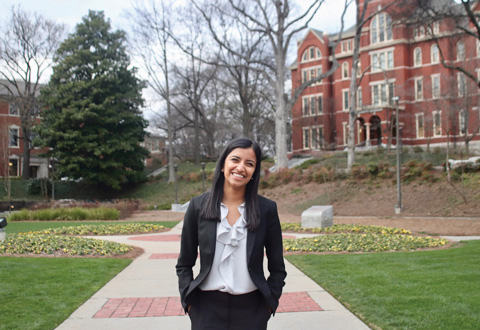 5. Pooja Juvekar
5. Pooja Juvekar
Industrial Engineering Student, Undergraduate SGA President
Judging by her list of commitments and responsibilities outside her studies at Georgia Tech, Pooja Juvekar likes to stay busy. She was elected the undergraduate study body president last summer and added that to her ongoing roles as an Alumni Association Student Ambassador. She’s served as executive vice president of her sorority, Alpha Delta Pi, performed undergraduate research at the Work Science Center on campus and was director of internal affairs for Tech’s Institute of Industrial & Systems Engineers student chapter. But Juvekar has held a true passion for Tech’s student government, having been part of it since her first year on campus. One of her main goals during her term as SGA president is to increase communication and engagement between SGA and the student body. “I want SGA to be the most active that it’s been,” Pooja says. “I want it to be the most energized and engaged that it’s been.” Based on her stellar track record of success? Count on exactly that happening.
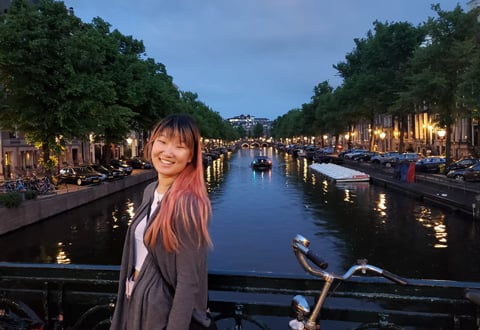 6. Emily Madsen
6. Emily Madsen
Biomedical Engineering Student
Emily Madsen is a biomedical engineering (BME) student who is using her skills as a painter and sculptor to illuminate complex topics. Through a student-run program based at Emory and Georgia Tech called Science.Art.Wonder., she's created a series of works designed to creatively interpret scientific research. She has worked with several researchers at Georgia Tech to bring art together with science in an effort to spark discussion about the researchers’ complex scientific topics. Madsen, who is entering her third year in BME, has worked across departments to translate their research into art. One of them, Stephen Beckett, says her sculpture depicting his research, “really explores how various types of abstractions can make us think and feel differently about our observations. It really captures some of the key steps in the scientific process.”
7. Candice Blacknall
Joint MBA/MD Student
If you ask Candice Blacknall, she’ll say that her journey to medicine was non-traditional. In fact, she says it choose her rather than her choosing it—she’d always wanted to be cultural anthropologist. As a combat medic in the U.S. Army, she found that medicine was an opportunity for her to combine the community service, team-driven world of the military with the creative world of the social sciences. “Much like an anthropologist, when I enter a patient’s room, I am entering a world separate from my own,” Blacknall says. “I have to learn their language as I assist them in devising goals for their health and mapping the route that will help them achieve these goals.” By choosing a joint MBA/MD degree between Tech’s Scheller College of Business and the Morehouse School of Medicine, she’s added a third world to the mix. “I’m looking forward to learning the language of business and building relationships with the people that speak it. I love a new challenge so I’m motivated to discover the ways the MBA program will nurture my instinctive need to innovate and the ways my MBA colleagues will broaden my perspective by sharing their experiences.”
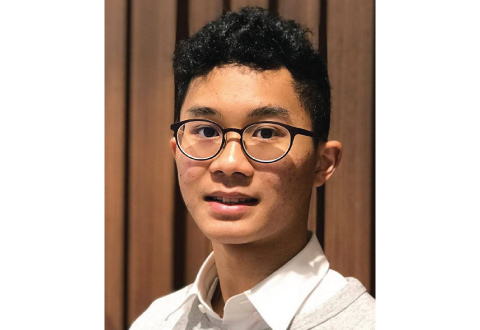 8. Alex IP
8. Alex IP
Environmental Engineering Student
Alex Ip has just started on his Tech environmental engineering degree, but he’s already built a tool for connecting with scientists and researchers around the world. His website, The Xylom, is a place specifically geared for scientists where they can share personal stories outside of their research and talk about everything from faith to race relations. Ip recently received a Millennium Fellowship to help him continue to develop The Xylom as a venue for connecting science professionals with each other, empowering voices less heard and building grassroots efforts. This spring, Ip also joined Atlanta’s Climate Reality Leadership Corps. Created through Al Gore’s Climate Reality Project, the Corps is charged to build a worldwide network of climate crisis activists to spread awareness and work on solutions. “We have passed the point where only reducing our wasteful behavior could be a catch-all solution,” Ip says. “We need to adapt and minimize the damage. As an environmental engineer, I have to be informed and engage with stakeholders so we can work together to tackle these problems.”
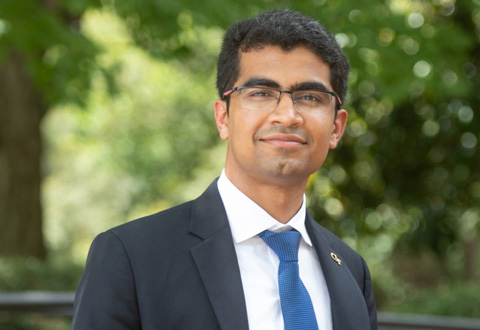 9. Narayan Shirolkar
9. Narayan Shirolkar
Doctoral Material Science and Engineering Student, Graduate SGA President
As president of Tech’s graduate student body, Narayan Shirolkar is working for change where his fellow Yellow Jackets can feel it: their wallets. Financial stress is a real concern for grad students on limited budgets and he’s already made an impact in his own academic department, leading a team that successfully researched and lobbied for a 22-percent increase in PhD stipends for students in materials science. And now he wants to look at other doctoral programs to see if they merit stipend increases, investigate the lowering of mandatory fees for all students and improve the availability of inexpensive dining options. Shirolkar loves Georgia Tech and he simply wants to make it even better. He particularly appreciates how engaged graduate students are at the Institute. “Although we are a highly ranked research institution, our grad students are doing amazing things beyond their labs,” says Shirolkar, whose own research focuses on the development of high-strength carbon fibers. “They’re running advocacy programs. They’re hosting K-12 outreach programs for students, and there’s a student organization for almost anything.”
Big Ideas
 1. Bringing The Gym Class Right Into Your Living Room
1. Bringing The Gym Class Right Into Your Living Room
John Foley, IE 94, and CTO, Yony Feng, CmpE 06, MS ECE 07
Sometimes the biggest ideas are the simplest ones. For instance, what if you could get the regimented, low-impact workout of a spin class in the comfort of your own living room? That is essentially the idea at the heart of Peloton, the bike and shared-exercise experience company cofounded in 2012 by Tech alums John Foley and Yony Feng. Foley was a competitive cyclist, triathlete, and all-around fitness buff who had trouble fitting classes into his schedule as CEO of tech companies Evite.com and Pronto.com and president of Barnesandnoble.com. Partnering with Feng, Foley’s new endeavor paired a sleek, high-end exercise bike with easy-to-use technology that delivers an online spin class into homes via a virtual cycling studio. A 22-inch touchscreen brings it all alive for workout warriors, and a monthly gym-class subscription model keeps revenues flowing for the company. The tech in the bike allows you to hone and monitor your exercise and performance, while the online capability gives you the instruction—as well as the peer motivation of immersive social media. Peloton has since expanded its offerings to treadmills and fitness apps and, to significant fanfare recently, the company successfully went public.
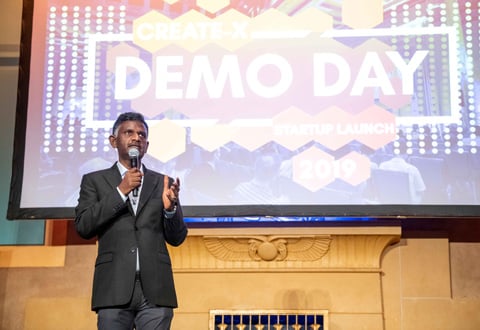 2. Becoming The World's Top Startup Campus
2. Becoming The World's Top Startup Campus
Instilling entrepreneurial confidence in students and empowering them to launch real startups has become an increasingly important part of a Georgia Tech education. CREATE-X is an initiative that follows a Learn-Make-Launch programmatic process, where students explore entrepreneurship through experiential learning and receive seed funding, legal assistance and intensive coaching from Tech experts. “With CREATE-X and other initiatives on campus, we are working toward making Georgia Tech the No. 1 startup campus in the world,” says Raghupathy Sivakumar, CREATE-X’s founding director and the Wayne C. Holman Chair professor in electrical and computer engineering. “Over the last five years, we have launched over 150 companies that now have an aggregate valuation of more than $300 million. Our student founders have created dozens of jobs right here in Atlanta and have brought in tens of millions of dollars in investment into the state." Adds Steve McLaughlin, dean of Tech’s College of Engineering and Southern Company chair: “Today’s students are increasingly interested in either starting their own businesses or joining a startup. CREATE-X lets our students explore innovation at an incredibly creative time of their lives, and we provide an ideal situation for them to try—succeed or fail—in a supportive and learning environment.”
 3. Bringing The Internet To The Neonatal Ward
3. Bringing The Internet To The Neonatal Ward
Georgia Tech alumnus Lou Malice, IM 80, is the CEO for NFANT Labs, a medical device and digital health company dedicated to improving the standard of care in infant feeding. In the United States, up to 70 percent of infants born prematurely and troubles with feeding can result in significant health problems for the infant. The company’s nfant Feeding Solution provides a non-invasive, diagnostic biofeedback way to help clinicians identify and treat an infant’s ability to feed safely and efficiently, leveraging machine learning and predictive analytics. It’s also the first Internet of Things (IoT) device cleared by the FDA for Neonatal Intensive Care Units. In working to bring the tool to market, Malice—a veteran in the medical device field—got some added help from Tech’s Advanced Technology Development Center (ATDC) Signature business incubator program. “ATDC gives businesses like ours access to expert advisers, qualified personnel, potential customers and partners, and learning programs that startups can leverage to fill gaps to their advantage,” Malice says.
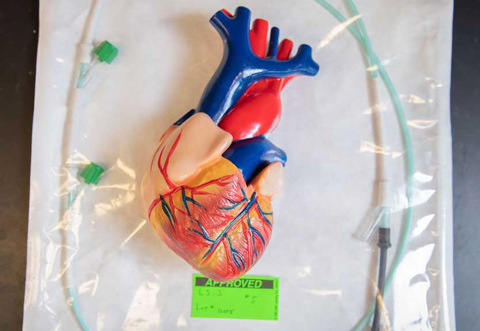 4. Mending A Broken Heart
4. Mending A Broken Heart
By this time tomorrow, your heart will have beaten 100,000 times. “It’s an amazing electromechanical pump that keeps on going in some people for 60, 70, or 80 years without needing a single repair,” says Ajit Yoganathan, a Regents Professor at Georgia Tech. Institute researchers—engineers, scientists and doctors—are working hard to make sure it stays beating in numerous ways. A collagen patch infused with regenerative protein could treat a heart attack. An RNA injection could replace electronic pacemaker. Stem cell injections could strengthen babies’ hearts before surgery. A-fib medication could be delivered straight to the heart with few side effects. A wearable monitor could alert doctors when it’s time to change medications. All these treatments and more are being investigated by Tech experts. And while they are not yet available for use on patients, they show real promise.
 5. Reinventing The Toilet (To Provide Sanitation For 2.5 Billion People)
5. Reinventing The Toilet (To Provide Sanitation For 2.5 Billion People)
There’s a shiny black espresso machine prominently displayed in Shannon Yee’s office in Tech’s George W. Woodruff School of Mechanical Engineering. While Yee is indeed a coffee drinker, there’s a more important reason for the machine’s presence: Its compact and efficient design may hold the key to meeting the needs of the approximately 2.5 billion people worldwide who now lack improved sanitation. An associate professor specializing in energy technologies, Yee is leading a $13.5 million effort funded by the Bill & Melinda Gates Foundation to reinvent the toilet—technology that hasn’t changed much in more than a century. High pressure, heat, and control of liquids are essential to making a good cup of espresso. They are also critical for a creating a 21st-century toilet that can operate with no plumbing or sewerage connections and as small an amount of electricity as a single solar panel could provide. Earlier research made significant progress, but gaps remain. Now research teams at Tech and other schools have 42 months to figure out how to make six new toilet prototypes ready for a commercial manufacturer.
 6. Sending Tiny Satellites Into Big Space
6. Sending Tiny Satellites Into Big Space
Our future in space looks small—really small. This summer, years of planning, design and testing paid off for hundreds of Georgia Tech students and young alumni who made up the brain trust behind the latest Tech-built satellite sent to space. Prox-1 measures about the size of a suitcase, weighs 154 pounds and is extremely delicate. It was part of the payload aboard the third launch of the SpaceX Falcon Heavy—the world’s most powerful operational rocket. Prox-1’s mission was to deploy LightSail, a solar sailing satellite developed by the Planetary Society. Grayson Huggins, AE 19, had just graduated but was part of the student team that built and tested Prox-1. “It is really one of my proudest achievements in my life, and it’s something nobody can ever take away from me,” said Huggins, who interned at NASA’s Jet Propulsion Laboratory this summer. “Something I built is in space, and that’s amazing to be able to say at 22 years old.” But this wasn’t Tech’s first nanosatellite rodeo. Two cubesats developed by students and researchers for the RANGE Project were successfully launched into orbit in December 2018 on board the SpaceX Falcon-9. And more nanosatellite projects are on the horizon.
 7. Bringing Tech's Top Master's Programs Online (For Less)
7. Bringing Tech's Top Master's Programs Online (For Less)
In January 2014, Georgia Tech, Udacity and AT&T teamed up to launch the first online master’s of science (OMS) degree in computer science from an accredited university that students can earn exclusively through the massive open online course (MOOC) format—and for a fraction of the cost of traditional, residential programs. This collaboration brought together leaders in education and industry to apply the disruptive power of technology to widen the pipeline of high-quality, educated talent in great demand in computer science fields. And the world took notice. In the 5-plus years since, the program has received more than 25,000 applications and enrolled more than 10,000 students, many of them already working professionals and all geting the same Georgia Tech experience as their on-campus counterparts. Due to the success of the OMS CS program, the Institute has since expanded its online master’s offerings in two other, high-demand fields—analytics and cybersecurity. These online programs provide the same rigor and end result: a highly sought after degree from Georgia Tech.
 8. Returning To The Moon (And Then Going To Mars)
8. Returning To The Moon (And Then Going To Mars)
NASA’s Artemis program plans to take people back to the moon by 2024—including the first woman—and three Georgia Tech graduates are among those who will help get them there. Alumni astronauts Eric Boe, MS EE 97, Shane Kimbrough, MS OR 98, and Doug Wheelock, MS AE 92, are all working on Artemis. “Only 12 people have ever walked on the moon,” Kimbrough says. “All were American men. Putting the first female boots on the moon will inspire a new generation of students, especially girls, to pursue STEM fields.” Collaborating with commercial and international space partners, NASA hopes to use new technologies to make long space flights more sustainable and surface explorations more thorough. NASA’s powerful new rocket, the Space Launch System, will send astronauts aboard the Orion spacecraft a quarter million miles from Earth to lunar orbit. Astronauts will dock Orion at the orbiting spaceship Gateway where they will live and work around the Moon. The crew will take to the surface of the Moon in a new human landing system before returning to the orbital outpost. The crew—hopefully manned by Tech astronauts—will ultimately return to Earth aboard Orion.
 9. Innovating A New Food Source (For Livestock)
9. Innovating A New Food Source (For Livestock)
Sean Warner and Patrick Pittaluga, Co-founders, Grubbly Farms
Cousins and fellow Yellow Jackets Sean Warner, BC 15, and Patrick Pittaluga, BA 14, saw that the future of food was in edible insects. Together, they bought 700 black soldier-fly grubs and housed them in their laundry with the intent of turning the bugs into burgers. But after the pair tested their new product on some friends, they pivoted to using their stock for chicken feed. And after going through CREATE-X Startup Launch, a Georgia Tech initiative to give entrepreneurial students the confidence and know-how to build their own businesses, Grubbly Farms was hatched. Grubblies are Warner’s and Pittaluga’s snacks for chickens that are not only nutritious for the birds, but also good for the environment. Before being dehydrated and packaged as feed, the black soldier flies are fed pre-consumer food waste from places like bakeries, breweries, and restaurants. Warner and Pittaluga estimate that for every pound of feed, about 10 pounds of food waste is spared from the landfills.
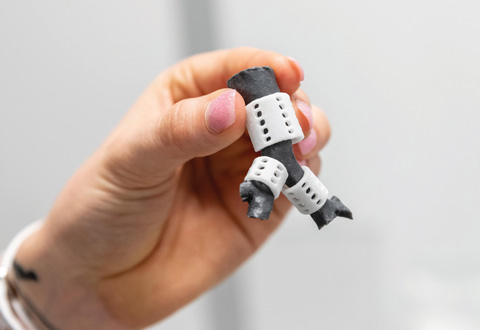 10. 3D - Biological Tissues and Implants
10. 3D - Biological Tissues and Implants
We’re not quite to the point where doctors can build us new, customized organs to replace our worn-out ones, but the idea is no longer just the fantasies of speculative science fiction. For example, Scott Hollister, who holds the Patsy and Alan Dorris Endowed Chair in Pediatric Technology at Georgia Tech and Children’s Healthcare of Atlanta, has developed a 3D-printed tracheal splint that’s been successfully placed in a pediatric patient. “The possibility of using 3D-printing technology to save the life of a child is our motivation in the lab every day,” says Hollister, who is also the director of Tech’s Center for 3D Medical Fabrication and a professor in the Wallace H. Coulter Department of Biomedical Engineering. Meanwhile, Professor Michael Davis, director of the Children’s Heart Research and Outcomes (HeRO) Center, is working to produce 3D-printed heart valves and patches, while many other researchers on Tech’s campus are developing a wide range of 3D-printed biotissues and materials.


